






As one of Australia’s largest broadband networks, our dedicated and experienced nbn® New Developments team has delivered nbn network access to more than 1.2 million new development premises nationwide.
We can do more for your build

Make nbn part of the plan
Visit nbn.com.au/newdevelopments
As we step into a new financial year, the 2030 net zero deadline draws closer, and utilities are faced with more pressure to reduce emissions while tackling the impacts of climate change. Both the federal and state budgets for 2023–24 have placed a focus on sustainable energy, water infrastructure and protecting the health of critical water systems, with funding being allocated to major projects across the energy and water sectors.
As we race towards net zero, the phrase “no transition without transmission” remains front of mind in the energy sector. In this August edition of Utility we follow Australia’s largest transmission project, EnergyConnect, and hear from Transgrid about the project’s recent milestones. On a smaller – but no less important – scale we spoke with the project director of the Alice Springs Future Grid project about its recent virtual power plant (VPP) trial and the incredible teamwork propelling the red centre towards its renewables target.
As we move closer towards unlocking the potential of green hydrogen, the question of transmission once again comes into play. APA has taken the first steps towards utilising its existing gas pipeline network as a method of transporting hydrogen, and has completed the first successful pressurised hydrogen test on a gas transmission pipeline in Australia.
Whilst utilities are still dealing with the aftermath of the flooding events of early 2023, the Bureau of Meteorology’s recent El Niño alerts and predictions of hotter drier conditions pose a threat to water security. With the future in mind, Melbourne’s water corporations have banded together to form a joint strategy that aims to balance the city’s water needs and secure supply for the next five decades.
Waste management also has an important role to play in achieving water
utilities’ net zero environmental impact goals. Recognising this, Sydney Water is taking steps to activate a circular economy in Western Parkland City by embarking on the construction of what will be one of the most advanced wastewater recycling facilities in the southern hemisphere.
Extreme weather, population growth and net zero targets have led to lots of exciting developments for digital technology. In response to the 2022 River Murray flooding event, SA Power Networks utilised AI and LiDAR technology to assess network damage and risk through digital flood impact modelling. While to the east, Hunter Water joined forces with CSIRO to trial in-situ sensors, satellite remote sensing, and modelling to deliver real-time water quality information for its Grahamstown reservoir and the Williams River.
Despite the many challenges facing both the energy and water sectors, the industry is continually pushing forward, pioneering new technologies and implementing better systems for the safe and reliable delivery of essential services. This innovation and resilience is something that Utility Magazine celebrates, and we hope you love this edition as much as we do.
Katie Livingston Editor



With Project EnergyConnect progressing well and in the delivery phase and Eyre Peninsula Link completed earlier this year, ElectraNet is now looking at the next set of priorities for transmission across the state that will continue to make the clean energy future a reality.
ElectraNet published the 2022 Transmission Annual Planning Report (TAPR) last October, but a government policy announcement1 and a rapid increase in connection activities have led it to publish an update in May 2023 ahead of the regular TAPR publication in October 2023.
ElectraNet has an eye to the future and is mindful of the cost of infrastructure and the potential wholesale costs of not meeting demand using low cost renewables. This TAPR update is seeking input from interested stakeholders on the directions and prioritisation of work, which ElectraNet will provide to AEMO for consideration in the 2024 ISP. ElectraNet is also working with SA Power Networks on the potential impact of increased electrification and the uptake of electric vehicles on the network.
There has been an increase in load connections interest across mining, data centres, processing and hydrogen, which equates to an additional load requirement of about 2000MW in South Australia. Combined with renewable generator connection activity, this is almost 3000MW of connections in South Australia. This is a massive increase in likely consumption compared with the AEMO 2022 ISP scenarios and its draft 2023 Inputs in the Assumptions and Scenarios Report (IASR). ElectraNet commissioned Energeia to assess demand under a full electrification scenario for South Australia. Given more recent information Energeia considered that electrification could occur faster than predicted in the draft 2023 IASR as outlined in Figure 1.
ElectraNet has analysed the locations of the new load connection interest across the state as outlined in Figure 2.
This recent level of interest in connecting load has led ElectraNet to consider prioritising the renewable energy zones (REZs) to unlock new renewable generation.
Figure 3 indicates the various REZ zones. ElectraNet is proposing the following prioritised zones:
• S3 – Mid North SA
• S2 – Riverland
• S5 – Northern SA
• S8 – Eastern Eyre Peninsula
• S1 – South East SA
1 https://www.safa.sa.gov.au/environmental-s-governance/energy/hydrogen-jobs-plan
SE Expansion (stage 1)
Eyre peninsula upgrade
Mid North Expansion (Northern)
Improve existing transmission capacity
Tailem bend to Tungkillo
Upgrade the voltage of transmission lines Cultana to Yadnarie
New transmission lines Bundey to Cultana
The prioritisation of these REZs leads to a focus on large -scale transmission developments needed to cater for the new demand, growth in renewable energy and South Australia’s hydrogen production.
The near-term transmission priorities are depicted in Figure 4 and outlined in the table below. A range of actions are proposed to progress these project options to be ready to meet the demand outlook. The proposed REZ prioritisation is subject to consultation as part of the TAPR update and further analysis by ElectraNet and AEMO as part of the development of the 2024 ISP and future TAPRs. These nearterm transmission priorities will also be subject to further analysis and consultation as part of ElectraNet’s regulatory investment test processes. This allows continual assessment of renewable generation and load connection enquiries, so transmission is built to meet the reasonable needs of committed connection.
Mid to late 2020s
Mid 2020s to early 2030s
Commence RIT-T
Require Preparatory activities in 2024

The SA Hydrogen Jobs Plan, the Magnetite Strategy and other industrial load opportunities all lead the way to increased jobs and for SA to become a world-class low-cost hydrogen supplier and green steel manufacturer. It is important to enable low-cost renewable generation onto the grid to lower costs to consumers, and to improve supply diversity and security of supply for consumers, all while having an eye on future net zero scenarios and climate change impacts.
As the speed of the transition increases, there will be a need to be agile and to keep an eye on the future. It is important to have genuine engagement and for regulatory processes to support timely approvals and project financeability.

The impact of climate change is one of the greatest issues that water utilities face; and with unprecedented weather conditions already threatening water operations, now is the time to act. To assist senior managers, executives, governing bodies and boards, WSAA has developed a paper that will identify the pathway and key steps that leaders can take to achieve net zero carbon emissions.
Antonio Guterres, the SecretaryGeneral of the United Nations, highlighted that “Climate change is the defining issue of our time, and this is the defining time to act”. The Intergovernmental Panel on Climate Change (IPCC) Report released in March 2023 states that emissions need to be cut by almost half by 2030, if warming is to be limited to 1.5°C.
Now is the time to accelerate towards net zero and the water industry has committed to align reductions with that timeframe, and many utilities are striving for ambitious targets. The stakes could not be higher for the water industry. In Australia, recent weather events have seen records broken through bushfires and floods, with intense extreme weather events becoming more common and having increasingly dangerous impacts
on communities and infrastructure. Working with the rest of the world to meet and exceed global emissions targets is vital.
The urban water industry must reduce emissions in ways that sustain value for customers and shareholders, grow businesses, and assist the community to adapt to climate change. This can be done in a way that reduces costs to the community while improving the liveability of cities and towns, boosting public health and economic prosperity.
Water utilities stand to be impacted more than most sectors, being one of the largest government contributors to carbon emissions due to the nature of our products. However, many utilities are at the forefront of achieving net zero carbon emissions by being more efficient with resources, minimising
To read the Climate Change – Accelerating to Net Zero paper, visit here: www.wsaa.asn.au/publication/climate-change-accelerating-net-zero-0
emissions and developing innovative ways of harnessing the potential resource production of assets through products such as biochar.
This paper seeks to build on the WSAA Towards Resilience paper, released in November 2021, and provide the elements required to develop a net zero roadmap, integrated with strategic objectives and supported by key actions to build quick wins and maturity and expand beyond the boundaries of the traditional water business. This high-level guidance is underpinned by detailed guidance and case studies to provide practical assistance to practitioners.

Transform your utility’s workflow with powerful works management software

Xugo is a cloud-based solution that powers the compliance, control and vegetation management activities across your business.
Access the insights needed to take actions, implement programs and meet your regulatory requirements
Create, manage, schedule and allocate work cases and tasks
Configure workflows and forms to your requirements
Visualise work progress
Capture complaints, incidents, and feedback directly from your customers and your teams
Store your complete collection of information relating to inspections, tasks, incidents, maintenance history, safety and environmental checks, investigations and analysis
Run and publish interactive reports
Engage with your mobile teams wherever you are via Xugo’s app in real-time
Scan to learn how Xugo makes utility regulatory compliance easy
Configurable to fit your requirements, and with an Australian-based team on hand to assist and enhance your workflow, Xugo delivers efficiency benefits without disrupting your business model.
The first pipes for the $983 million Fitzroy to Gladstone pipeline have arrived in Rockhampton, signalling that preparations are underway for the start of construction.
The 117km pipeline will run from the Lower Fitzroy River in Rockhampton and connect to Gladstone Area Water Board’s existing water network at Yarwun, set to provide long-term water security to Gladstone’s industry and support ongoing economic development in the region.
The Queensland Government approved construction of the $983 million Fitzroy to Gladstone pipeline, with $548.5 million to be spent in 2023–24 to continue the delivery of the project.
To assist the Gladstone Area Water Board with funding the project, the State Budget included an equity allocation of $550 million made possible by the uplift in royalty revenue.
The pipeline will have the capacity to transport 30GL per annum from the Fitzroy River to Gladstone.
The pipes are being manufactured by Steel Mains Pty Ltd – an Australian manufacturer and supplier of complete steel pipelines for the transportation of water and wastewater.
Works are underway and the expected project completion is late 2026, weather and construction conditions permitting.
Queensland Minister for Water and Member for Gladstone, Glenn Butcher, said, “The 117km pipeline will deliver longterm water security to the Gladstone region to support more
www.ams-ic.com.au
AMS have been suppliers of instrumentation and calibration equipment to all industries since 1973 representing some of the world’s leading manufacturers of the equipment in their field.








job creating industries – this is good for jobs now and into the future.
“The funding locked in as part of the Big Build is proof of the Queensland Government’s commitment to Central Queenslanders.
“The Bradfield panel recommended investing in the use of water closer to where it falls as well as developing Regional Water Grids, and we are doing just that.”
Queensland Member for Rockhampton, Barry O’Rourke, said, “We’re eager to see the lasting positive legacy that the Fitzroy to Gladstone pipeline will have on our region as a result of the Queensland Government’s commitment to supporting local content and workforce.
“We expect to see at least 40 per cent of Fitzroy to Gladstone pipeline construction costs spent locally throughout the duration of project delivery, which will be a fantastic opportunity and economic boost for Rockhampton.”
Gladstone Area Water Board Chief Executive Officer, Darren Barlow, said, “This is a significant milestone for the delivery of the Fitzroy to Gladstone pipeline and is a great opportunity to ensure that this project is on Central Queenslander’s radars.
“The McConnell Dowell BMD Joint Venture team has spent the past three months negotiating with landholders, procuring equipment and materials, and starting works at the Gracemere laydown area and workers camp to gear up for start of construction in August this year.”


The development of the Hydrogen Park Murray Valley renewable hydrogen plant has reached a new milestone, with the Australian Gas Infrastructure Group (AGIG) reaching financial close on the project in June 2023.
On behalf of the Federal Government, the Australian Renewable Energy Agency (ARENA) announced a $36.1 million commitment to AGIG for the 10MW electrolyser deployment in Wodonga, Victoria.
The project builds on ARENA’s existing work in renewable hydrogen and strong track record of delivering transformative projects in the energy transition in pursuit of net zero.
The Hydrogen Park Murray Valley project will produce renewable hydrogen to initially be blended into the local natural gas distribution network, owned by Australian Gas Networks, part of AGIG.
The facility will be located next to North East Water’s Wodonga Wastewater Treatment Plant. Once complete, the project will be the largest renewable hydrogen facility on the east coast and equal largest in Australia.
The renewable hydrogen produced will displace natural gas supplied to local customers and industry at blends of up to ten per cent, reducing carbon emissions with no change to amenity for gas users.
We have a range of jetting trucks to suite your application.
Safe, reliable, and cost effective.
With more than 40,000 connections to the local gas network, the project will supply hydrogen to an estimated 85,000 people spanning the border of Victoria and New South Wales. At a blend of ten per cent, the project is predicted to cut approximately 4,000 tonnes of CO2 each year.
Wodonga’s strategic location along a major road freight route also provides access to other end use markets, particularly in heavy vehicle transport.
The Victorian State Government is supporting the project with $12.3 million through the State Department of Energy, Environment and Climate Action (DEECA), with additional financial backing from the Clean Energy Finance Corporation (CEFC).
Mars Petcare Australia will purchase Renewable Gas Guarantee of Origin certificates, generated by the project and accredited by GreenPower, to match the gas use of their local pet food factory in Wodonga.
Hydrogen Park Murray Valley is the second 10MW project supported by ARENA to reach financial close after the first, Engie’s Project Yuri in the Pilbara, achieved the milestone in September 2021. Both were funded as part of a $103 million competitive funding round for commercial scale hydrogen electrolyser projects.
ARENA Chief Executive Officer, Darren Miller, said the project is paving the way for renewable hydrogen in Australia.
“It’s essential to scaling up Australia’s renewable hydrogen industry that we get these first-generation projects up and running,” Mr Miller said.

“Producing renewable hydrogen on this scale has never been done in Australia. The lessons we learn here will help inform our hydrogen industry as it grows from its early stages to a pillar of the net zero economy.
“ARENA has been at the forefront of advancing renewable hydrogen projects and will continue to play an integral role, as we support the Australian Government’s Hydrogen Headstart program and other large scale projects.
What’s exciting about this project is that it will be producing hydrogen that reduces local emissions from day one, with the potential to supply additional markets as they move towards net zero.”
AGIG Chief Executive Officer, Craig de Laine, said that AGIG is proud to work with both the Australian and Victorian Governments on this landmark project.
“The strong support received from both the Federal and State Governments demonstrates the importance of renewable hydrogen to decarbonising energy across Australia. We thank all our project partners and key stakeholders, including the Albury-Wodonga community for their contribution to the project to date.”
Since 2017, ARENA has committed more than $255 million in renewable hydrogen projects. ARENA will also play a key role in the development of the Federal Government’s $2 billion Hydrogen Headstart initiative to underwrite the biggest green hydrogen projects to be built in Australia.
Construction on the project is due to commence in 2023, with the site operational by 2025.


Transgrid has released its $16.5 billion roadmap, which reveals how the company is looking to transform New South Wales’s energy grid to a more sustainable and cost-efficient network.
The System Security Roadmap outlines the New South Wales Transgrid’s detailed plan to grow the state’s power system and ensure the secure operation of the grid at up to 100 per cent instantaneous renewables over the next decade.
Transgrid is undertaking a major program of works across three critical pillars to build and operate a safe, reliable and low emissions power system:
• Energy Reliability: investing $14 billion to build a 2,500km energy superhighway of essential transmission lines and infrastructure to connect new large-scale renewable energy and storage to the grid, integrate five renewable energy zones, and expand transmission interconnection between regions and states
• System Security: deploy an estimated $2.2 billion in new system-strength technologies and services to maintain the secure operating envelope of the grid without the operation of coal generation
• Operability: a step-change in analytical and operational capabilities and capacity, to operate an increasingly complex power system, with a $300 million investment to strengthen Transgrid’s technology tools, workforce and training
Transgrid CEO, Brett Redman, said modernising the energy grid to bring energy prices down requires building enormous amounts of new transmission to connect renewable generation in record time.
“The only way to bring energy prices down is to deliver cheaper renewable energy as soon as possible. Transgrid must build and operate the backbone of this new grid while ensuring the safety, reliability and security of our existing 13,000km transmission system which powers millions of homes and businesses.
“With over 80 per cent of coal-fired capacity in New South Wales expected to retire and 28GW of new renewable and storage capacity coming online in the next ten years, we must urgently accelerate the investment in all areas of the energy transition.”
Mr Redman said Transgrid is accelerating delivery of the new energy superhighway with nation-critical projects including EnergyConnect, HumeLink and VNI West vital to facilitate Australia’s clean energy transformation.
“There will be no transition without transmission. However, the enormity of the task and the challenges we face must not be understated. We must embrace innovation, invest in technology, develop a larger and more skilled workforce, and strengthen our capabilities, if we are to achieve a rapid transition to a low emissions energy system providing clean, affordable and reliable electricity to Australians,” Mr Redman said.

The Water Industry Operators Association of Australia (WIOA) has announced the winner of its Ixom Best Tasting Tap Water in Tasmania competition, held in Mowbray on 4 July 2023.
Fern Tree was announced the winner after competing against Glen Huon and Barrington in the grand finals. All water suppliers in the state were invited to submit a sample of their finest drop to compete for the award.
Fern Tree will have bragging rights over other water suppliers in Tasmania for the next 12 months, and will battle it out against the best from other states for the Australian title in November 2023, which will be hosted in Victoria.
The annual Ixom Best Tasting Tap Water competition is designed as a fun way to raise awareness of the quality of drinking water in Australia, and to recognise the efforts of local water service providers in delivering valuable water services to their communities.
Water samples are subjected to a blind taste test and rated according to the Water Tasting Wheel, which outlines some of the attributes that water professionals use when judging water such as colour, clarity,
odour and taste – think wine tasting without needing to spit out the samples once you’re done.
WIOA Managing Director, George Wall, said, “The competition recognises and acknowledges the individuals and organisations that are stepping up, some in very trying circumstances, to make sure their communities are supplied with safe drinking water every day.
“We want to use the competition to let people know the great work that is going on in local communities around Australia, and help to shape and secure Australia’s water future.”
Mr Wall also acknowledged Ixom’s support of the Best Tasting Tap Water competition.
“Thanks to Ixom’s unwavering commitment and support of the industry, we have been able to continue running the competition,” Mr Wall said.
The winner of the Ixom 2023 Best Tasting Tap Water in Australia competition will go on to represent Australia at the annual Berkeley Springs International Water Tasting Competition in West Virginia, US.

“I was looking for reliability, service and customer support, and almost three decades on I’ve stuck by the Vermeer Australia team for their incomparable service.”
Jeff Trackson, JR & LM Trackson Pty Ltd

Congratulations to Jeff and Linda Trackson on the delivery of their 33rd Vermeer drill, and the first of its kind to be delivered in Australia, the D100x140 S3. This long-standing relationship with the Trackson Group of Companies is invaluable to us, and we’re proud to be able to offer our customers not only state of the art equipment, but the kind of service and support that keeps them coming back year after year.
For all your HDD and pipeline requirements, talk to your local Vermeer Australia team.
VERMEERAUSTRALIA.COM.AU
1300 VERMEER Vermeer and the Vermeer logo are trademarks of Vermeer Manufacturing Company in the United States and /or other countries. Product specifications are subject to change by OEM. © 2023 RDO Equipment Pty Ltd (trading as Vermeer Australia). All Rights Reserved.
Acontract has been awarded for the latest big battery to be connected to the South West Interconnected System (SWIS), which will be built at Collie in Western Australia.
The contract to build the 197MW battery was awarded to Neoen by the Australian Energy Market Operator, following a competitive process initiated with the State Government through Energy Policy Western Australia’s Coordinator of Energy.
The Neoen big battery is in addition to a new battery funded in the 2023–24 Western Australia State Budget, which will be one of the biggest battery systems in the world, providing around 500MW for up to four hours.
Western Australia Energy Minister, Bill Johnston, said, “I warmly welcome the investment by Neoen in the State’s
energy market, which represents a key component of the Cook Government’s Energy Transformation Strategy.
“While the Western Australia Government is replacing its coal-fired energy capacity with renewable infrastructure through Synergy, it is also critical for the private sector to take up the opportunity of participating and benefitting from the State’s energy transition.
“Big batteries like this one will help smooth out the peaks and troughs in the South West Interconnected System by storing energy during times of low demand and releasing it into the grid in times of peak demand.
“It will complement Synergy’s new battery at Kwinana and the $2.3 billion investment announced in the recent State Budget for further battery storage capacity in the SWIS.”
Neoen is one of the world’s leading producers of renewable energy. The Collie Battery will be its sixth big battery in Australia.
The long duration battery is expected to be operational by the summer of 2024/25, when it will be providing 197MW for up to four hours.
The new piece of energy infrastructure will be a significant boost for the security and reliability of the South-West’s electricity grid, especially during the evening peak periods.
The SWIS electricity grid supplies Perth and more than one million homes and businesses between Geraldton and Esperance and east to Kalgoorlie.
The Collie Battery will directly create more than 120 construction jobs, as well as many new opportunities for suppliers in the Collie region.


Unitywater has announced it will be investing $1.8 billion over the next five years to increase the reliability and quality of water and wastewater services and contribute to the liveability of southeast Queensland.
Executive Manager Sustainable Infrastructure Solutions, Daniel Lambert, said the utility operates in one of the fastest growing areas in the country, and planning is taking place to meet the needs of residents and businesses.
“As we plan for the coming decades and what our future communities will look like, particularly in the lead-up to the Olympics, it’s important to consider infrastructure and projects that help enhance the liveability of our region,” Mr Lambert said.
“We are continuously looking for ways to reduce our operating footprint and balance investment with the challenges of a growing population, flood risk and changing weather patterns.”
Mr Lambert said the major projects taking place were a mix of pipes, pumps and treatment plants, as well as naturebased treatment and renewable energy initiatives.
“Our Aura water project will include the construction of a new water reservoir and 12km of pipeline to connect to the Ewen Maddock Water Treatment Plant, providing a new water network for Aura to meet future demand.
“The wastewater project will include the installation of a new wastewater pump station and 12.5km of new pipeline to transfer wastewater to our Kawana Wastewater Treatment Plant.”
The program will also deliver a new water reservoir at Tanawha and installation of 2.6km of new water pipeline in Harmony. Another milestone project is the Wamuran Irrigation Scheme, which will provide year-round water security for a number of local farmers while reusing treated wastewater from the South Caboolture Wastewater Treatment Plant.
Mr Lambert said Unitywater was committed to delivering sustainable and reliable infrastructure that will improve the network’s overall reliability and to ensuring that customers demand water and wastewater is met both now and in the future.
“This also includes the roll out of smart water meters, which can help identify hidden leaks which has saved Unitywater customers more than $1 million on bills and 231 million litres of water over the last two years during its initial trial.”

Link-Seals offer hundreds of solutions to seal pipe penetrations ranging in size from 10mm to 3.6 metres diameter.
Link-Seals are suitable for most types of pipes including PVC, HDPE, Copper and Steel.
Resistant to water, oil, gas, aggressive chemicals and fire.
Projex Group helps calculate the right Link-Seal size and model for your application.



Locusview's technology manages the entire utility infrastructure construction process from planning to execution and closeout. Faster, Safer, Smar ter


APA Group has announced that construction is complete on the first stage of its East Coast Grid expansion, a project that is set to boost gas supply across the east coast providing energy security and supporting Australia’s energy transition.
Stage one works included the construction of a single site of compression on both the South West Queensland Pipeline and Moomba Sydney Pipeline. Stage two works commenced in May 2022 and are expected to be complete by winter 2024.
APA Chief Executive Officer and Managing Director, Adam Watson, said the business’ decision in 2021 to invest in a 25 per cent expansion of the East Coast Grid is already delivering
essential capacity to customers and southern markets, particularly in the peak winter periods.
“Two years ago, we could see there was going to be a need for greater gas transmission capacity for the northern producers delivering gas to the southern markets. We wanted to get ahead of this demand to ensure we could support the needs of our customers and our communities” Mr Watson said.
“The first stage of our East Coast Grid expansion is now complete, with the second stage under construction and expected to be complete in readiness for the growing winter demand in 2024.
“In this financial year alone, APA will have invested more than $340 million across a range of projects, including the
East Coast Grid expansion, to facilitate increased gas supply to meet peak demand in southern markets.
“These are critical investments that we are making now, recognising the vital role APA plays as a leading Australian energy infrastructure business to deliver additional energy security ahead of forecast supply shortfalls in a cost-effective way.”
Construction on the South West Pipeline expansion is expected to be completed by August 2023, followed shortly after by the completion of the Western Outer Ring Main (WORM) gas transmission project, further boosting capacity across the region.
“When completed, these projects will further enhance system capacity, reliability and security of supply to Victorian households and businesses, as well as supporting the gas-fired



power generation that is essential for backing in and backing up renewables,” Mr Watson said.
“It is so important that as a nation, we continue to invest in domestic gas as the most secure, affordable and low emissions pathway to accelerate the energy transition and build out more renewables.
“We’ve demonstrated the benefits of an efficient incremental approach to increasing supply with our staged expansion, but these investments were only possible because of the existing regulatory environment and an assumption that this will continue into the future.
“Governments need to ensure the right regulatory environment is in place to promote the necessary investment required to achieve our nation’s ambitions and ultimately ensure the transition is orderly.”
Providing the highest confidence in level measurement in the most challenging conditions
● Easy installation and confidence in your data with the REFLECTTILT TM LED indicator





● Configure REFLECT with your application parameters using the secure browser-based Bluetooth® connection and user-definable range


● Accurate and repeatable FMCW radar technology for the most challenging conditions, even in the presence of dust, temperature changes, moisture, pressure and chemicals




















































































Early bird registration is open for Engineers Australia’s flagship conference, Climate Smart Engineering 2023 (CSE23), to be held at the Melbourne Convention and Exhibition Centre on 29-30 November 2023.
CSE23 is a focal point for debate and knowledge sharing on solutions to address climate change. It will attract experts from a range of professions, industries, government and business sectors.
Across two days, CSE23 will highlight innovative engineering solutions that address climate change. Speakers will demonstrate why it is important for sustainable practices and environmental considerations to be at the forefront of everything we do.
The conference will feature a full technical program supported by plenary sessions, networking opportunities
and exhibitors. Showcasing the latest in world-leading views, CSE23 will facilitate discussions on responding to extreme events, biodiversity loss, boosting the circular economy and upholding the principles of sustainable practices in engineering.
As creative problem solvers and systems thinkers, engineers are at the forefront of the fight against climate change. The profession stewards the delivery of mitigation and adaptation strategies to address the worst impacts of global warming and innovates to deploy new technologies for a clean energy future.
Want to save on your ticket to CSE23? Take advantage of early bird discounts and join Engineers Australia for the must-attend sustainability conference of 2023. For more information and to register for early bird rates visit www.engineersaustralia.org.au/cse




Connecting engineering minds, ideas and opportunities, Climate Smart Engineering Conference (CSE23) will showcase the latest solutions to pave the way for net zero emissions in Australia. Book early and save up to $210.
Register now engineersaustralia.org.au/cse

With more than 50 years of electrical engineering experience, and as one of the pioneers in the Australian and New Zealand electric vehicle (EV) charging landscape, NHP has developed a range of quality EV charging products to suit the needs of all operations, including utilities, councils and other government projects and facilities.
NHP partners with Delta, one of the world’s largest EV charger manufacturers, to bring high-quality charging products to Australia and New Zealand. This Delta range has been further enhanced to provide a number of products including charging posts, isolators, RCBOs, EV readiness distribution boards and even the revolutionary NHP Load Management System.
To provide further support, NHP employs a team of dedicated EV specialists and engineers to tailor the right solution for each unique application and provide a bespoke service and maintenance package, which involves NHP’s factory-trained technicians checking on the installation to ensure that it is operating in tip-top condition.
The Delta range of EV chargers from NHP features Ethernet, Wi-Fi and SIM card connectivity, allowing connection to third-party cloud-based billing platforms via the OCPP 1.6J communications protocol.
Durable, reliable and commercial grade, the Delta DC Wallbox 25kW is one of the best selling, low level DC
chargers on the market, while the all new Delta DC Wallbox 50kW will be a game changer in the EV charging space.
One of the thinnest chargers on the market at only 260mm deep, the DC Wallbox 50kW delivers fast charging without large real estate demands.
The range comes with cable lengths starting from 4m, which is ideal for carparks, while the optional 7m cable length is ideal for utilities, councils, heavy commercial and automotive service centres. Air-cooled, steel-cased and with an IP55/IK10 rating, the Delta DC Wallbox will operate comfortably in most weather and operating conditions and will run at full capacity up to 50°C.
The DC Wallbox can be wall-mounted, which allows cabling to run along the wall, rather than digging trenches. If no wall is available, the DC Wallbox is available with a purpose-built steel pedestal.
The Delta DC City Charger is built inside a solid steel IP55/ IK10 case and is robust and built for longevity. Available in three variants (50kW, 100kW and 200kW), the City Charger will deliver rapid and ultra-rapid performance.
This DC charger is suited to both metropolitan and regional locations and is designed for Australia and New Zealand’s varying environments and weather conditions. Air cooling is used for temperature control, making the DC City Charger more reliable and easy to maintain.
NHP has kept the power on in homes, stadiums, hospitals, factories and many other industries for more than 50 years. The team understands the importance of reliability and up-time, and thus offers a wide range of service and maintenance products and extended warranties. The company’s Services and Solutions team can also travel to your plant to install and commission EV chargers.
To find out more, please contact your local NHP Account Representative, call 1300 647 647 or email nhpsales@nhp.com.au.
NHP’s range of enclosures can provide you with:
■ IP66 ingress protection
■ High thermal management efficiency in direct sunlight

NHP is the local distributor for nVent Hoffman and Fibox, delivering a range of enclosures designed and tested for outdoor use. Whether you need protection from the sun, water, dust or vandals, there’ll be floor or wall standing enclosures to suit your needs and eliminate the risk of component failure.
■ A choice of many different sizes available off the shelf. Speak to your local NHP Account Representative to guide you to the ideal solution for your business or project.


The start of a new financial year can be a hectic time for businesses, but it’s also the ideal time to review your super to ensure that you can step into 2024 with confidence.
Brighter Super has been supporting energy and electrical utility workers for more than 40 years to reach their retirement dreams and is committed to doing this as much as possible face-to-face.
Kate Farrar, CEO of Brighter Super, said, “It’s a busy administrative time of year, but don’t forget to plan ahead to ensure you are getting the most out of superannuation.
“We have been listening to what our industry members want and need, and one of those things was not to lose our personalised approach as we grow. We really listened and today have more than 40 consultants on the ground, more
than any other superannuation, ready to meet members and support them on their retirement journey.
“We’ve seen thousands of members in the last year, and these are the three C’s that we recommend all employees should consider at this time of year.”
1. Check – that your retirement is on track. Request a super health check with your super fund.
2. Consolidate – find out if you’re paying fees on multiple accounts and discuss consolidation with your super fund.
3. Contribute – Consider your budget and whether you are able to make additional contributions.
A little planning now can go a long way to making 2024 a brighter financial year.
Brighter Super is a proud Queensland not-for-profit fund, and with 259,000 members and $29 billion funds under management is also one of Queensland’s largest nongovernment financial institutions.
With headquarters based in Queensland, we are the industry super fund that has been supporting energy workers for over 40 years. Now with greater scale, we manage the retirement savings for over 250,000 members, which means we are able to increase the personal service our members want, and keep their fees lower.


Increasing urbanisation, housing density and the impacts of climate change pose both risks and opportunities for public land management. More and more, communities are recognising waterways’ values, growing the demand for better public access and the use of quality open spaces.
Consequently, there is growing pressure to restore and manage these waterways for multiple benefits, with an increasing number of diverse stakeholders and other land managers (e.g. state transport authorities, park authorities, and Traditional Owners).
Shared goals that intersect waterways need more research into how utilities can bring their community and stakeholders along for the journey in an intelligent, meaningful way.
In 2022, DEECA, in partnership with Melbourne Water, commissioned Mosaic Insights consultancy to develop an Integrated Place Management Framework. The framework provides guidance for the collaborative management of waterways and Crown land to deliver environmental, economic, social and cultural outcomes.
Backed by research and evidence, the framework is applicable to a broad range of practitioners and is designed to be adaptable rather than prescriptive. The framework serves as a guide for assessing whether to apply an integrated place management approach (it might not be appropriate for every project) and provides tools and strategies for implementing a collaborative approach.
The histories behind Melbourne’s urban waterways and their varied public values illustrates the complexities of land management collaboration that landowners/managers navigate today.
Melbourne, with a history of being ranked among the world’s most liveable cities, hosts a significant range of waterways – around 25,000km of rivers and creeks.
For Greater Melbourne’s Traditional Owners, the Wurundjeri, Bunurong, Taungurung and Wadawurrung peoples, the waterways and surrounding lands have
Across the globe, the effective management of urban waterways is becoming a priority. Waterways often intersect with utility land, council land, Crown land, parks or reserves, public land managed by community groups or other committees of management, and private land. So, how do we achieve optimal community outcomes for the varied interest groups? New research commissioned by Melbourne Water and Victoria’s Department of Energy, Environment and Climate Action (DEECA) suggests that in many cases, collaboration is the key to achieving the best outcomes for all.
held cultural and spiritual connections for thousands of generations. Waterways have been, and are still seen as living, integrated, natural, and cultural entities by the region’s Traditional Owners.
Since colonisation in Australia, Melbourne’s waterways have a varied history of use and value.
Europeans colonised Melbourne in 1835 – allured by the geographical advantages like the safety of Port Phillip Bay and the fresh water provided by the Yarra River (Birrarung). By the 1860s, the Victorian gold rush had driven extensive investment into the city, which meant that its population was growing at a rapid pace and expansion was expedited.
Utility services struggled to keep up with booming growth and consequently, much of the city – particularly the Yarra River – became severely polluted, with many small creeks suffering from erosion.
By the late 1800s Melbourne became colloquially dubbed ‘Smellbourne’. The city’s drainage networks and waterways were contaminated with untreated waste, and public health concerns were at an all-time high.
In 1891, with a desperate need for an authorising body to take responsibility for the city’s water supply and sewage treatment, Melbourne Water’s predecessor, Melbourne and Metropolitan Board of Works (MMBW) was formed.
Approximately 157,000ha of the Yarra Ranges forest area was closed to the public for rainwater catchment, storage and filtration. Melbourne currently remains one of only a handful of cities around the world with protected water catchments.
The following year, MMBW began building Melbourne’s world-leading sewerage and drainage system, which included the construction of a treatment farm at Werribee (now known as Western Treatment Plant). This meant that the stormwater draining system was able to be separated from the sewerage system.
This was a great feat for connecting Melbourne homes to sewerage systems, but the decision to split the systems inadvertently resulted in stormwater and urban runoff draining almost entirely into the waterways.
By the 1970s, public opinion on the value of the environment and open spaces was beginning to change. In general, environmental awareness was increasing across Melbourne and other parts of the developed world.
By 1971, the Victorian Environmental Protection Authority (EPA) had been established, and the Victorian Government’s city planners had published an early vision for Melbourne’s open space network called Planning Policies for Metropolitan Melbourne. Open space corridors for waterways – including the Yarra River (Birrarung) – were identified in the 1971 metropolitan plan, and soon after, land acquisition began to form green networks as well as trail systems to connect them. In 1980, a campaign ran in The Age newspaper called ‘Give the Yarra A Go’, which brought the poor condition of the lower Yarra (as well as other smaller creeks) to the attention of the public – which was instrumental in highlighting the Yarra (Birrarung) as a valued community asset.
In the decades that followed, community groups sprang up to advocate for waterways and services or delivered them themselves.
Recently, Melbourne – like much of the world – has witnessed a growing focus on the social and cultural aspects of urban waterway management, and the roles these play in greening cities.
The COVID-19 lockdowns demonstrated just how vital waterways (blue spaces) and parks, gardens, and other open spaces (green spaces) are to community health and well-being, during which there was a significant increase in visitation to these areas.
There is also a growing focus on the cultural value of waterways, and the connection that Traditional Owners
have to Country, despite the dramatic modifications to the landscape caused by urbanisation.
The Wurundjeri, Bunurong, Taungurung and Wadawurrung people have cared for and lived on the lands and waters of Greater Melbourne for over 40,000 years. Though it is well established that Country is central to Aboriginal people’s sense of identity and culture, Traditional Owners have historically been denied sovereignty and a voice in the governance of land and waterways.
In 2022, the Victorian Government released Burndap Birrarung burndap umarkoo, the Yarra Strategic Plan – a ten-year plan for the Yarra River corridor. Burndap Birrarung burndap umarkoo translates to ‘what is good for Yarra is good for all’ in Woi-wurrung language.
The first-of-its-kind plan to protect and enhance the Yarra River, Birrarung as one living and integrated entity, and its implementation is being led by Melbourne Water.
The plan is designed to support the Wurundjeri and Bunurong Traditional Owners’ co-management of the river and was prepared through a collaborative governance approach by the Yarra Collaboration Committee, with Traditional Owner partnership central to this approach. This collaborative governance approach will coordinate joint actions laid out in the plan and investment across a multitude of state and local government agencies to ensure the best outcomes possible for the Yarra River (Birrarung).
Plan Melbourne 2017–2050 calls on all public landowners to deliver social, economic and environmental benefits as efficiently as possible by activating under-utilised public land. This is echoed in Melbourne’s Open Space for Everyone: Open Space for Metropolitan Melbourne 2021 strategy. The strategy stipulates an action to “investigate new governance, institutional arrangements and approaches to support place-based integrated land management and community participation in planning and decision-making” to protect and improve Melbourne’s network of blue-green spaces.
Melbourne Water is the second largest landowner in Victoria, managing 33,000ha of land across Greater Melbourne for operational purposes and managing 25,000km of waterways.
In 2022, the Port Phillip and Westernport Catchment Management Authority (PPWCMA) integrated into Melbourne Water, marking the beginning of a single, integrated entity with a shared vision for catchment and waterways management across the Port Phillip and Western Port region.
Acknowledging its role in ensuring that there is better access to places for communities to meet, recharge and connect with nature, Melbourne Water’s Corporate Plan 2021–22 to 2025–26 commits to delivering a new blue-green corridor planning program to maximise opportunities for recreation and leisure. It also commits to implementing strategies, guidelines and projects to make the most of open space for community health and well-being.
Dr Craig Grocke, Adjunct Senior Lecturer, University of Tasmania, said collaboration is key to achieving these commitments in managing open space.
“One solution is co-management or stewardship with other land managers and communities who are keen to access and activate waterway land,” Dr Grocke said. This requires understanding what partnership are best to use in different circumstances, which is where the Integrated Place Management Framework is beneficial.
The development of the framework was informed by an extensive research process, which included interviews with place management experts; literature reviews of existing policies, guidelines and procedures; and analysis of five case studies.
When multiple land managers, stakeholders, or land tenures intersect within a site-specific project, integrated place management can be a key tool for land management.
As evidenced by the research conducted by Mosaic Insights, integrated place management is rooted in two key elements:
• Place-based: framing challenges and opportunities with a specific place at the centre
• Focus on collaborative processes: keeping collaborative processes at the heart of integrated place management by fostering enduring and trusted relationships between stakeholders
The place-based approach ensures a meaningful connection point between stakeholders.
Within the framework, integrated place management is considered to encompass three collaborative stages:
• Co-governance: formal arrangements to share decision-making. This includes the institutional and organisational arrangements and usually results in a formal agreement between key parties.
• Co-planning: planning together under co-governance agreements. This represents a collaborative approach to project development whereby the interests and values of each of the stakeholders are incorporated into project plans.
• Co-management: actions and responsibilities implemented jointly by the parties. This can build on the previous two levels of collaboration and is a stage in which responsibilities and actions are clarified and establishes how the desired goals or outcomes will be carried out and achieved.
When asked what integrated place management meant to them, the expert interviewees gave varied responses, but with consistent messaging when it came to the principles of authentic collaboration and partnerships to achieve shared outcomes.
“Place is about delivery and connections and relationships rather than legislation. Often, place is a really valuable anchor point for bringing people along,” Expert Interviewee 1 said.
For another interviewee, integrated place management was not just about collaboration, but about distributing power.
“In its purest sense, co-governance is the devolution of power so that each party that sits around that table has equal decision-making authority,” Expert Interviewee 3 said.
When integrated place management is well executed, it can create enhanced and more holistic outcomes including efficient and effective management; longevity in relationships; faster resolution of issues; a stronger sense of community and place attachment; and improved community health and well-being.
For Traditional Owners, integrated place management supports self-determination and delivers greater cultural and heritage outcomes. Traditional Owners see Country as whole and connected and implore agencies to walk together across boundaries.
Importantly, integrated place management helps situate the specific site within the broader context and landscape allowing for opportunities to connect with broader green infrastructure and open space networks. This enhances the potential for biodiversity corridors contributing to urban greening and cooling objectives to improve climate change resilience.
That said, integrated place management is not always the appropriate solution, particularly within the co-governance stage.
Developing the framework provided several key learnings about integrated place management approaches and highlighted that, for practitioners, applying a ‘learning by doing’ process and adaptive management philosophy will be integral to success.
A key theme that emerged during the development of the framework was the importance of allowing time to build meaningful relationships and seeking genuine involvement, rather than merely seeking feedback.
The Integrated Place Management Framework provides guidance in this assessment process and prompts practitioners to consider important factors like the number of stakeholders involved, the stage of the project, the duration and longevity of the project, and whether it’s a public or private project (e.g. whether the project involves the private use of public land).
Where it’s appropriate to use other approaches, the lessons from integrated place management can be used as a reference, however, it’s critical to clearly communicate with stakeholders whether integrated place management is occurring and in what capacity. Without clear communication, trust and rapport between stakeholders are put at risk.
The framework sets out a five-step process to guide the application of integrated place management:
Step 1: Decide whether integrated place management is appropriate for your project
Step 2: Ensure that your project supports the principles of integrated place management
Step 3: Consider your project’s complexity and the likely proportion of time and effort required for each stage
Step 4: Identify the appropriate tools and strategies for implementing each stage
Step 5: Document and share progress, outcomes and lessons learned on integrated place management
While there is no ‘one-size-fits-all’ approach to integrated place management, these steps can help guide the practitioner in determining the appropriate approach for their project.
“You don’t go in asking ‘what are your thoughts on this plan?’, you go in seeking a relationship, and that takes a lot of time,” Expert Interviewee 1 said.
There is also a fine balance to be struck between having a trusted administrator to facilitate and manage relationships (particularly in co-governance arrangements) and relying too heavily on an individual ‘champion’ within an organisation. The latter can be challenging when dealing with staff turnover, which can result in the loss of a stakeholder relationship. However, this is manageable by engaging entire stakeholder organisations, including senior management, and developing succession plans for stakeholder representatives.
Finally, a critical lesson to keep in mind is to ensure bureaucratic processes are fit-for-purpose, transparent and streamlined to avoid missing out on opportunities.
It is important to ensure projects are outcome-focused and responsive to the needs of the community – which means developing and maintaining strong stakeholder relationships.
Collaboration is often key to achieving shared outcomes, but there are complexities and nuances to each project, landowner/manager, and community. By implementing a considered and tailored integrated place management approach the community and key stakeholders can be brought along the journey towards a shared vision. Not only does this minimise social licensing risks, but it also means more support for landowners and utilities in achieving collective outcomes and optimising shared spaces.
For more information, visit: www.environment.vic.gov.au/suburban-parks/openspace-for-everyone/integrated-place-management
Dja Dja Wurrung Clans Aboriginal Corporation, more recently known as DJAARA, has launched the Dja Dja Wurrung Climate Change Strategy: Turning ‘wrong way’ climate, ‘right way’, which advocates for direct djaara leadership and a more holistic approach to climate, Country and people.
The strategy was released on 24 May 2023 at Wanyarra Dum (Frog Ponds) in White Hills, and emphasises the importance of Dja Dja Wurrung People (djaara) leadership in both mitigating climate change and adapting to the impacts of a changing climate.
The Dja Dja Wurrung Climate Change Strategy was developed by collaborating with a diverse group of Dja Dja Wurrung People (djaara) to find out what they felt was best for Dja Dja Wurrung Country (djandak). It follows DJAARA’s Renewable Energy and Forest Gardening strategies, both released in 2022.
DJAARA CEO Rodney Carter highlighted the company’s unique approach to healing climate, which is outlined in the strategy.
“Climate change is driven by colonial and western approaches to natural resource management where people, Country and climate are seen as separate,” Mr Carter said.
“Dja Dja Wurrung take a holistic approach to climate action based on the principle that people, Country and climate are
connected through spirit. Healing climate, healing Country and healing Dja Dja Wurrung People are very connected.
“Our Dja Dja Wurrung Climate Change Strategy brings together work that DJAARA is already leading on Country – including around natural resource management, cultural burning, forest gardening and other healing activities on Country,” Mr Carter said.
The climate change strategy combines with DJAARA’s renewable energy plan, nyuawi mutjeka, meaning ‘to keep the sun’, which outlines how DJAARA intends to pursue opportunities for renewable energy production and consumption that protects and supports djaara and djandak
The strategy lists a number of Aboriginal and Torres Strait Islander-led projects that can help djaara be more selfsufficient and climate conscious on djandak, such as solar generation systems, battery energy storage systems, and electric vehicles.

The climate strategy advocates for djaara to be central to all climate actions undertaken on djandak, as their traditional practices and cultural knowledge are uniquely placed to mitigate and adapt to climate change.
Mr Carter said Dja Dja Wurrung leadership is needed to effectively address the issue of climate change in central Victoria.
“As Traditional Owners, Dja Dja Wurrung People have been listening to and caring for Country for millennia. We are highly attuned to the health of Country and of climate,” Mr Carter said.
“Our biocultural knowledge makes us best placed to know what is most likely to be successful in terms of reducing and adapting to climate change.
“DJAARA is eager to engage with those who live on or share responsibility for Country, and walk together as we face the challenge of climate change.”
The strategy addresses climate change through six areas. Some of the objectives and actions under each area include:
• Climate change has made bushfires on djandak more extreme, and more harmful to Country, people and climate
• Cultural burning reduces the risk of extreme bushfires that release large amounts of carbon emissions, and fosters a healthier ecosystem
• Rainwater capture and storage can alleviate water scarcity for people and nature during times of drought
• Restoring native aquatic vegetation and biodiversity to rivers and waterways increases carbon storage in the land/waterscape
• Galk-galk dhelkunya (forest gardening) provides a suite of tools for djaara to lead land-based mitigation projects such as carbon farming, cultural burning, and revegetation
• Renewable energy projects on djandak such as wind and solar systems
• Initiatives that reduce pollution and carbon emissions, such as switching to electric vehicles
• Galk-galk dhelkunya (forest gardening) is a traditional practice that provides a variety of means to mitigate climate change
• Planting more heat and drought tolerant trees can reduce forest degradation
• Healthy forests rely on healthy waterways and rivers, increasing environmental resilience and carbon storage
• djaara owned and operated renewable energy projects
• Traditional djaara practices can help strengthen the environment and mitigate climate change
While distinct, these areas are deeply interwoven and are each permeated by a seventh concept murrun (spirit). This interconnection means that actions that affect one area will also affect the others. These areas form the framework through which DJAARA seeks to approach climate action, taking a holistic approach that considers the potential effects on all areas.
The areas combine and interact with the plants and animals of djandak to provide the seasonal indicators that form the djaara seasonal calendar, a traditional means of gauging how the land is being affected over time.
Utilising the djaara seasonal calendar is one tool Dja Dja Wurrung People can use to know if Country and climate are ‘right way’ or ‘wrong way’ (healthy or unhealthy). The presence or absence of key species in a given season, at a given time and in a given place provides the information needed to measure the success of DJAARA climate action in a culturally appropriate way.
DJAARA is a First Nations corporation that represents and advocates for Dja Dja Wurrung People and Country, and advances cultural, environmental and economic benefits for Traditional Owners and the wider community.
In 2008, the corporation gained Registered Aboriginal Party status for Dja Dja Wurrung people, a major step for djaara to be recognised as the Traditional Owners of djandak
On 28 March 2013, the Corporation, on behalf of djaara, and the Victorian Government signed the Recognition and Settlement agreement.
The agreement recognises and protects the unique and traditional relationship of Dja Dja Wurrung People to djandak now and into the future. It is the legal framework for engagement and collaboration between the Victorian Government and DJAARA, with a particular focus on ensuring djaara are able to practise culture on djandak
In 2021, the Dja Dja Wurrung Clans Aboriginal Corporation changed its name to ‘DJAARA – Balaki Wuka (Giving to community)’ to honour the people it represents.
For more information about the Climate Strategy, visit: https://djadjawurrung.com.au/djaara-launchesclimate-strategy-ahead-of-summit/
When it comes to sustainability in the utility industry, a broader perspective is needed to navigate the complex landscape effectively.
While the focus is often on the visible networks and services above the surface, true sustainability requires us to consider what lies beneath. The phrase 'out of sight, out of mind' is, unfortunately, rather apt here. Underground operations form the cornerstone of every project, yet these unseen elements frequently escape our attention, despite their significant environmental implications.
Let's explore five key beneath-ground sustainability factors and how experienced sustainability practitioners can guide utilities towards creating a more sustainable future.
1. ENVIRONMENTAL IMPACTS AND ECOSYSTEM PROTECTION
Underground activities in the utility sector can disrupt natural habitats and contaminate soil and water resources. It is imperative to employ stringent environmental management strategies, which include exhaustive impact assessments and proactive protective measures. These steps are essential to establishing operations that are not only sustainable, but also coexist harmoniously with nature. Continual environmental monitoring and assessments are crucial to remaining informed about your operation's environmental impact.
The importance of Environmental Social Governance (ESG) reporting in meeting regulatory requirements and maintaining transparency must be considered. As industry leaders, we are responsible for pursuing sustainability beneath the surface while upholding rigorous environmental standards.
2. CLIMATE CHANGE RISK, ADAPTATION, AND MITIGATION
As the climate changes, our response should adapt accordingly. Extreme weather events pose a growing threat to service delivery and environmental sustainability. Prioritising infrastructure resilience through planning, stormwater management, and climate adaptation measures can minimise the effects of climate change. Collaborating with climate risk and mitigation experts can provide the

necessary support, from natural hazard modelling to greenhouse gas emissions reduction plans, strengthening the resilience of our infrastructure.
3. MATERIAL SELECTION AND USAGE
Traditional construction materials like steel and concrete have significant carbon footprints. We must embrace alternative materials with lower environmental impact and sustainable sourcing practices to escape this carbonintensive cycle. Shifting our material selection towards greener options paves the way for a more sustainable future.
4. EFFECTIVE WASTE MANAGEMENT
Construction and maintenance activities generate substantial waste. We must outgrow the conventional "take-make-dispose" model, adopting recycling, reuse, and responsible disposal strategies. This approach minimises waste generation, diverts materials from landfills, contributes to a circular economy, and uncovers the overlooked potential of discarded resources.
5. WORKING HOLISTICALLY
Confronting sustainability challenges necessitates an integrated, holistic approach. This approach entails incorporating sustainable design principles, leveraging technological advancements, engaging stakeholders effectively, and driving ongoing monitoring and improvements. Collaboration amongst utility companies, industry bodies like the Infrastructure Sustainability Council, environmental experts, and community stakeholders is vital for instigating significant change and accomplishing longterm sustainability goals beneath the ground.
Sustainability is a complex field; each utility has unique factors to consider. If you find yourself seeking strategies to reduce your environmental footprint or boost your asset resilience – both above and below the surface – consider partnering with sustainability experts.
At Tonkin + Taylor, our expert environmental and geotechnical consultants are dedicated to providing sustainable solutions. We empower our clients to achieve their sustainability goals, as together, we create and sustain a better world.
To learn more, please visit www.tonkintaylor.com.au or email: australia@tonkintaylor.com.au
As a specialist provider of engineering and environmental services, Tonkin + Taylor brings your project ambitions to life.
With proven experience on large-scale projects across Australia and New Zealand, we are the specialist partner of choice.
From land development, transport, renewable energy, waste + resource recovery to water resource management, industry, and mining – we are passionate about creating and sustaining a better world together.

Find out more at...
www.tonkintaylor.com.au

Access covers are constantly exposed to Australia’s harsh climate, and this environment needs to be taken into account in their design. High-quality composite access covers are engineered to be resistant to these conditions, providing tailored solutions and reducing waste through longevity.
EJ has recently launched its composite access covers in Australia, which is proving to be a significant development for the Asia Pacific infrastructure industry. These innovative covers are engineered and tested to Australian Standards, for Australia’s harsh, challenging conditions. High quality composite access covers are lightweight and anti-corrosive, which provide new advantages and a fresh level of choice for project managers of utilities and municipalities, engineers and designers.
High-performance composite access covers are a relatively new arrival in the Australian market and come with many key benefits that make them a valuable solution across the board, and allows them to meet the specific needs of certain industry sectors. These benefits include:
• Ergonomic design – resulting in lower product weight
• Corrosion resistance – material resistance to corrosion for H2S or other chemicals
• No signal interference – radio frequency (RF) friendly for transfer of signals
• Environmentally friendly – low energy consumption in manufacturing
• Minimal risk of theft – due to no scrap value
• Variety of colour options – colours are permanent and UV resistant
The Australian Standard AS3996:2019 sets the industry benchmark for access covers, grates and frames for the Asia Pacific region. Composite products must meet a number of specified design features and a comprehensive series of tests that must be passed to fully comply with the Standard. These are:
1. Load resistance
» Serviceability: five repetitions of serviceability design load without exceeding allowable deflection limits and permanent set
» Ultimate: one application of ultimate limit state load without visible cracks or failure
2.

Watertight: no visible leakage under 150mm head of water for ten minutes.
» Gastight: no drop in pressure when tested at 0.5kPa for ten minutes
3. Slip resistance
» Patented EJ ‘4L’ slip resistant cleat on surface tested in accordance with AS4586 – wet pendulum test to P5
4. UV resistance
» All composite materials exposed to ultraviolet radiation shall be stabilized to ensure a minimum 25-year lifespan
5. Elevated temperature resistance
» Sustained application of the serviceability load for four hours at 50°C
6. Creep resistance
» Sustained application of the serviceability load for 24 hours at ambient temperature
7. Impact resistance
» Steel striker (3.75kg Class B/20kg Class D) dropped from 2.5m
8. Fatigue resistance
» Class D 300,000 cyclic load test to meet deflection and permanent set limits and no evidence of cracking
As an industry leader, EJ has commissioned its own research and testing to demonstrate its commitment to the Standard, ensuring that all requirements are met. The company maintains its own NATA Accredited testing facility in Brendale, Queensland and also utilises independent third party NATA test resources. To further demonstrate its full compliance with the Standard, EJ in the Asia Pacific is currently undertaking the product certification audit to AS3996:2019 with IAPMO R&T OceaniaMark. Additional approvals will be gained with WSAA for acceptance and use by water authorities and local councils.

High performance composite access covers by EJ. Engineered and tested to Australia’s harsh, challenging conditions.
Visit ejco.com to learn more about the resilient designs by EJ.

In the face of climate change and projected population growth, Melbourne’s water corporations have banded together to form Water for Life , a shared water plan that aims to balance the city’s water needs and secure supply for the next five decades. Developed by Greater Western Water, Melbourne Water, South East Water and Yarra Valley Water, this strategy aims to balance Melbourne’s water needs by increasing efficiencies, diversifying water sources and using new water supplies. Here we interviewed Greater Western Water Managing Director, Maree Lang, about the strategy and how the city’s utilities are preparing for the future.
One of four Melbourne water corporations, Greater Western Water, provides water and wastewater services to approximately 1.3 million people across Melbourne’s CBD and north-west suburbs and townships, and its jurisdiction is home to some of the fastest growing communities in Australia.
The Greater Melbourne Urban Water and System Strategy: Water for Life is a joint strategy produced by Greater Western Water, Melbourne Water, South East Water and Yarra Valley Water to ensure a safe and secure water supply for Greater Melbourne over the next 50 years, and includes specific actions for the next five years.
ML: Every five years, our four water corporations revise our existing urban water strategies and the water supply system strategy for Greater Melbourne.
This planning cycle is an important part of Victoria’s 50-year planning horizon to manage water supply and use across our service regions in the face of population growth and climate change, and means we can consider changes in our operating environment and latest knowledge to update our approach.
Given our communities share these big challenges, it made sense to deliver a single joint strategy, building on the many ways we already collaborate on outcomes. We launched Water for Life in April 2023 and have now started the five-year delivery phase together.
ML: Greater Melbourne is facing significant water challenges. Our population is growing and the economy is thriving, which means we're using more water, while urbanisation is increasing the amount of sewage and stormwater our systems need to manage.
Our climate is also changing. Warmer and drier conditions means there’ll be less water in our rivers and less water flowing into our supply system. We’re already experiencing the impacts of a more variable climate, with more extreme events like floods and bushfires.
Looking forward, under some climate and demand scenarios, we’ll start reaching an imbalance in supply and demand in the next ten years.
We have a collective responsibility to ensure that Greater Melbourne has enough water into the future. The best time to act is now while water storages are high and we have the benefit of time to forward plan a range of fit-for-purpose options to be ready when we need them.
WHAT STEPS IS WATER FOR LIFE TAKING TO PREPARE THE WATER SUPPLY FOR PROJECTED POPULATION GROWTH AS WELL AS THE EFFECTS OF CLIMATE
ML: The strategy outlines comprehensive options under three key themes – water efficiency solutions, integrated water management solutions and supply system augmentations. We know we can no longer rely solely on dams, and Water for Life emphasises drawing from a diverse range of water sources and transitioning to increased use of climate resilient, manufactured water.
Under each theme, we’ve identified pathways that focus either on reducing demand on our drinking water supply or adding new climate independent, manufactured water sources to the supply system.
Importantly, we are taking a best practice adaptive planning approach, which recognises there are multiple ways to respond to uncertainty and aims to keep as many options open as possible. We can’t forecast with certainty how quickly our population will grow over the next 50 years, how climate variability will impact water availability and how people will choose to use water, so investing in a range of water supply options gives us the flexibility to make informed decisions at the right time.
ML: The involvement of communities and Traditional Owners in the assessment and short-listing of water supply
options is an exciting aspect of the strategy development. We’re in this together, so it was important to get everyone around the table from the start to understand everyone’s different water values, needs and ideas.
We partnered with Traditional Owners to set direction for the strategy and ensure their priorities and cultural values were shaping decisions. An independently recruited panel of 36 community members shaped the strategy alongside us, informed by a broader public engagement program to gather insights and test our thinking.
We will continue actively involving customers and the community in decision making through ongoing implementation. Our focus now is sustained, meaningful Traditional Owner partnerships to work together in water management and planning, and to empower communities to take a more active role in water efficiency.
ML: Greater Melbourne’s water corporations are committed to providing access to water for First People’s self-determined use.
In developing this strategy, we’ve sought to honour and respect Traditional Owners’ status as our partners in water management. This is central to our desire to grow our cultural competency and establish genuine partnerships with Traditional Owners.
Water for Life lays the foundations for strong partnerships with Traditional Owners to deliver better planning and decision making outcomes. We will also support the Victorian Government to deliver commitments in the Central and Gippsland Region Sustainable Water Strategy to return water to Traditional Owners and the environment.
ML: Projects that support outcomes of the strategy are being coordinated through the recently established Managing Directors Accord that brings together leaders from Greater Western Water, Melbourne Water, South East Water, Yarra Valley Water and Barwon Water to tackle our big challenges together.
We’re now in a five-year implementation phase with each water corporation responsible for delivering key actions for their region under the strategy objectives. Water for Life will also deliver on policy directives in the Victorian Government’s Central and Gippsland Region Sustainable Water Strategy. These include supporting Melbourne households to achieve the new 150 litre daily water use target, returning water to Traditional Owners and ensuring healthy rivers and waterways across the region.
Our progress will be reviewed and reported on every year as part of the annual Melbourne Water Outlook.

As the cost of energy increases across Australia, selecting the optimal air and power generation solutions can help wastewater treatment plants mitigate these rising expenses. Here one industry leader breaks down these solutions, and shares helpful information on how to choose the right product for the job.
With recent announcements of energy costs increasing up to 20 per cent in some parts of Australia, the cost of power supply and air usage in industrial and process applications is likely to rise substantially. Supplying compressed air to activated sludge basins generally consumes more than 50 per cent of the total energy used in wastewater treatment, and some sources claim that up to 75 per cent of operating costs are related to aeration blowers. As initial investment costs are typically around three per cent of the total costs of new wastewater treatment plants, it pays in the long run for blowers and generators to be optimally sized and selected very carefully for their application.
Ambient conditions and process requirements change all the time, so selecting a blower size that is suited to maximum temperature conditions and maximum turndown with consistently high efficiency is something CAPS keeps in mind when helping you choose the right solution.
With many technologies and brands to choose from, it can be quite challenging to evaluate different blowers or compressors and select the best technology for your system. CAPS is an Australian owned and operated company with a full suite of low-pressure air solutions and the expertise to help you choose the right equipment to suit your needs.
The company’s range of positive displacement blowers, multi-stage centrifugal and single-stage centrifugal turbo blowers – which offer the best efficiency across the full operating range at all atmospheric conditions – are suited to
a variety of industrial wastewater treatment applications such as aeration, air scouring and filter backwashing.
The energy from waste industry (EfW) demands reliable back-up energy solutions to handle any prolonged interruptions due to unscheduled grid failures. Critical factors when selecting a back-up system are costs, minimising noise, and keeping the real estate footprint of the system as compact as possible.
Delivering a standby generator, especially for the EfW system, involves several challenges such as size constraints, rapid start-up, performance, and emissions concerns. CAPS keeps this at the forefront with its own brand of purpose-built generators designed specifically for Australian conditions. Made from leading OEM components such as Perkins engines, Leroy Somer alternators and Deep Seas controllers, CAPS’ soltutions strive for production continuity.
Established in 1980, CAPS boasts more than 43 years of experience in compressed air and power generation. In-house engineering allows CAPS to provide custom solutions to clients with specialised applications, and its state-of-the-art factory acceptance test bays ensures quality and compliance. As an independent company with the flexibility to search globally for the best products and technologies that best serve the Australian market’s needs, CAPS works alongside world-renowned partner brands such as Ingersoll Rand, Kohler, AIRMAN, Sauer, Next Turbo Technologies, Lamson and many more. With ten branches nationwide and 24/7 service for maintenance and emergency breakdowns, CAPS endeavours to lead the industry in service and solutions.
For more information, visit www.caps.com.au
CUSTOM ENGINEERED SOLUTIONS & WORLD RENOWNED BRANDS
• COMPRESSED AIR
• LOW AND HIGH PRESSURE AIR
• POWER GENERATION


Yarra Valley Water services approximately 4,000 square kilometers and about two million people in the northern and eastern suburbs of Melbourne, providing customers with drinking water, sewage services and recycled water supply. In March of 2023, Yarra Valley Water announced a new five-year partnership deal for its Pipes and Facilities Program, with the aim to improve the water, sewer, and recycled water infrastructure across the region. Here, we take a closer look at the program and how the new partnership will assist in the delivery of water services in Melbourne’s future.
With Melbourne’s population expected to grow to around seven million by 2026, the Growth Futures group is an integral part of the team at Yarra Valley Water. Led by General Manager – Growth Futures, Chris Brace, the Growth Futures team is accountable for the provision of water and sewerage services to new customers. A key focus for Mr Brace’s role is partnering with the community to develop new urban water futures that generate greater shared benefits for all stakeholders. Mr Brace and the team are accountable for the procurement of new infrastructure to service growth, as well as the delivery of major upgrade projects for existing infrastructure.
As part of its strategic planning, the team relaunched its Pipes and Facilities Framework panel in March 2023. The panel, which had previously comprised up to eight members, was reduced to three key strategic partnerships – Jaydo, Aqua Metro and MFJ Constructions. Mr Brace explained, “We really found that working more closely with a smaller number of players, we believe is a way to generate more efficiency and greater delivery certainty for our customers and to deliver our commitments and our pricing submission that we've just put into the Essential Services Commission. This panel will service about $40 to $60 million worth of capital works every year, predominantly pipeline work, but also pumping stations, things like pressure reducing valves, et cetera, in both new and emerging suburbs.”
The initial term for the partnership is five years, with the possibility of extension for up to ten years. Mr Brace said that the panel features a combination of new and existing contractors with Yarra Valley Water.
“Aqua Metro is a new panel member, they haven't worked with Yarra Valley Water previously but they have done a lot of work with Melbourne Water and Greater Western Water. JAYDO and MFJ have been on our panel for some time, and are trusted construction partners. We're pleased that they were successful in getting on the panel to continue our partnership.
“We are taking a slightly different approach, in that we're inviting these contractors in to work sort of like a virtual partnership as well. We had a governance meeting recently and we discussed how to deliver the program at the highest efficiency, lowest impact on the environment, best outcome for customers, minimising community disruption. And so it is a little bit of a different playing field for them, in that they are collaborating together as well as competing for projects on the panel.”
As Melbourne grows, a lot of areas will need new water, sewer and recycled water infrastructure. A lot of mediumsized capital projects, with costs ranging from low millions to tens of millions, will require new sewers, water mains and recycled water mains to service growth. The Pipes and Facilities Framework panel will operate with each of the companies tendering for each project – but they will also be participating in the program management.
“We will be looking at the pipeline of works that are coming and making sure that we're in alignment on what it's going to take to get the program done. Leveraging the
skills of each other to optimise how we get the work done. Working with the supply chain, pipeline supply, material supply, we'll be looking at opportunities to synergise in that space, but essentially they'll be tendering on a series of packages of work, either pipeline renewals or delivery of new water sewer and recycled water pipelines to growth areas,” Mr Brace said.
One of the key responsibilities of the partnership is to facilitate the successful delivery of commitments made to customers as part of Yarra Valley Water's 2030 strategy. But what are these commitments, and in what ways will this partnership help deliver them? Mr Brace explained, “Some of the key commitments in the price submission relate to reliable and timely services, minimising the number of interruptions that customers experience. This panel supports those outcomes by helping Yarra Valley Water renew the assets at the right time and with minimal disruption to the community when we do that. In bringing the contractors in close, we can optimise the design and minimise the impact on the environment, with the panel providing advice around how we can minimise the loss of trees, minimise the disruption in roads and shutdown times, things like that. We've got an approximately $1.9 billion dollar capital works program, which is really about servicing that growth, supporting those reliable services and making sure we are providing reliable drinking water supply and reliable sewage services to prevent spills to the environment. So, they're really going to be helping us get the projects done on time and minimising costs.”
This panel will support the renewal of quite a number of key infrastructure assets, water mains and sewers that either are reaching end of life or are reaching the limits of their capacity due to growth. As Melbourne grows and assets age, Yarra Valley Water believes bringing partners in to work more closely will help the utility understand the construction landscape better so that designs can be optimised. We can’t wait to see how the projects pan out.
DIGITALISATION MEANS THAT MORE AND MORE FIELD DEVICES ARE BEING NETWORKED WITH EACH OTHER. THIS MAKES THE QUESTION OF RELIABLE PROTECTION AGAINST
Cyber adversaries can be quite different in nature: they can range from individual hackers to criminals or even nation states. Such attacks are still rare in the process industry; however, operators need to be vigilant as any attacks on IT can affect OT areas very quickly.
Despite the risks, this new open-endedness offers numerous advantages for users.
For example, level sensors provide important data across many different areas of industrial activity at all locations, allowing worldwide inventory management. Wireless data transmission is also used to retrieve status information from the sensors, for example to report maintenance requirements or to request an update, reducing downtime.
The development of wireless communication with Bluetooth has also increased the use of this solution, as it makes the adjustment and commissioning of sensors and controllers easier – which can also help avoid accidents.
Yet from a cyber security perspective, there are challenges. This data is increasingly being bundled into production and maintenance systems so that it can then be further processed in the office or control room. This creates discontinuities between operational and security functions.
For this reason, VEGA put great effort into achieving certification as per IEC 62443-4-2 (an international series of standards that provide a flexible framework for systematically assessing, evaluating and implementing security requirements for hardware as well as software) while it was developing the VEGAPULS 6X radar level gauge. The entire development process of VEGAPULS 6X was therefore geared to these standards, including an analysis of possible threats in order to identify weak points and develop countermeasures at an early stage.
These safety measures include the encapsulated electronics of VEGAPULS 6X, which prevents manipulation, and a built-in Defense-in-Depth strategy (a tiered security concept that consists of several IT security layers, production
Digital networking is forging ahead rapidly in the process industry, and modern, integrated automation solutions are simplifying handling and making processes more flexible and efficient. However, this technology opens up new avenues into the previously self-contained automation level and can offer a convenient entryway for attacks.
equipment security, network security and the security strategies of the various system components). This provides protection against data manipulation, denial of service and espionage.
Security features of the VEGAPULS 6X are:
• User authentication: including an individual device code and Bluetooth access code. Bluetooth connections are encrypted and offer the user the option to be deactivated again after the device has been configured.
• Event memory: VEGAPULS 6X records both successful and unsuccessful locking and unlocking attempts in an event memory.
• Firmware integrity checks: the software update package is encrypted and signed. This prevents unauthorised software from being loaded into VEGAPULS 6X.
• Data backup for recovery.
When defending against a cyber attack, time is of the essence. All companies should make appropriate preparations, which include drawing up both a clearly defined emergency plan and a plan for rebuilding a secure system after damage. The VEGA PSIRT (Product Security Incident Response Team) stands ready at all times, continuously searching for vulnerabilities, assisting with updates and patches, answering questions and taking action in critical situations. VEGA also works closely with CERT@VDE, an IT security platform for industrial companies, in reporting and investigating vulnerabilities.
Cyber security is an ongoing dynamic process that requires constant attention from the operator. VEGAPULS 6X is designed to ensure that the user doesn’t have to worry about the area of application, the technology involved, the frequency or version of the sensor. VEGA strives to make everything as simple as possible when it comes to cyber security, including by encouraging the operator to apply the measures mentioned in the security guidelines, which enable them to use the sensor correctly and securely; and offering additional tips on making a production system more secure, ensuring that users are optimally prepared.





IT DOESN’T JUST MEASURE VALUES. IT HAS VALUES. THE 6X ®. AVAILABLE NOW!
The VEGAPULS 6X: A radar level sensor that is not only technically perfect, it also takes the user into account. It’s easy to set up and at home in virtually any process or industrial environment. Made by a company that bases its decisions on values that are good for everybody.
VEGA. HOME OF VALUES.
www.vega.com/radar
CSIRO and the SmartSat Cooperative Research Centre (SmartSat CRC) have partnered with industry and research partners to form the AquaWatch mission, aimed at developing a comprehensive national inland and coastal water quality information service.

The mission’s goal is to help safeguard freshwater and coastal resources and grow Australia’s space capability.
AquaWatch combines data from innovative ground-based equipment and satellite remote sensing to monitor and forecast the presence of cyanobacteria in drinking and recreational water sources.
Hunter Water’s Grahamstown Reservoir near Newcastle is one of multiple sites participating in the national pilot program.
Andy Olrich leads the Continuous Improvement and Innovation team, and James Van Der Helm is a water scientist with Science and Research at Hunter Water. Andy and James recently presented their technical paper on Hunter Water’s involvement in the mission at Ozwater’23 in Sydney.
Using pilot sites at Lake Hume, on the New South Wales and Victorian border, Lake Tuggeranong in the ACT, and the
Grahamstown Reservoir, CSIRO aims to grow the program into a national integrated system that can provide holistic aquatic ecosystem information.
Hunter Water has partnered with CSIRO on a trial of the in-situ sensors, satellite remote sensing, and modelling to deliver real-time water quality information for Grahamstown reservoir and the Williams River.
“It's really exciting that we are utilising our national space program to help drive better ways of managing water quality through our rivers and coastal water resources,” said Mr Olrich.
“It's cutting-edge space technology and water science coming together for the benefit of potentially millions of people here and around the world.”
According to Mr Van Der Helm, the mission is centred around monitoring for the presence of algae, which has a serious impact on water quality.
“When conditions are favourable for algae to accumulate in the water at sufficient concentrations, the algae can release colours, as well as taste and odours, into the water,” said Mr Van Der Helm.
“The pigments change the reflectance signature of the water, so the instrumentation is actually looking at that change in reflectance, which is calibrated against blue-green algae, suspended solids and coloured dissolved organic matter.
“Using data and algorithms, we can monitor current algal conditions and forecast or predict the likelihood of an algal bloom occurring.”
Everyone needs and deserves access to clean, safe drinking water, and as we move toward an uncertain climate future, we need as many tools as possible to manage those resources.
“The system has potential to provide cost-effective water quality monitoring that can be deployed across the globe,” said Mr Van Der Helm.
“After we have finished the process of local calibration and validation, then we may no longer need to rely on the regular manual aspects of water quality monitoring and sampling and analysis of water samples.
“We can utilise satellite remote sensing technology and imagery to assess water quality and the likely risk of algal blooms occurring. So, it's very, very exciting from that perspective, and has immediate local relevance as well as international relevance.”
Hunter Water provides water and wastewater services to almost 600,000 people in the lower Hunter region on the east coast of Australia. Some of the benefits the utility and its customers will see as a result of this mission include:
Hazards and resources (people, vehicles, boats) associated with manual sampling of water in Grahamstown Reservoir will be reduced through application of this
technology. James believes the technology will lead to fewer manual inspections for algal risk.
Grahamstown Reservoir has a surface area of 28 square kilometres and Hunter Water performs weekly water quality monitoring, from three discrete points in the reservoir. Gaining real-time and complete visualisation of the site’s water quality is a great opportunity for Hunter Water.
Through real-time monitoring and forecasting, the mission aims to provide water resources managers and utilities with a tool for management of algal risk. A typical sampling, laboratory analysis and reporting of results can take about seven days. Initial trials indicate the potential to reduce the exposure windows (time from sample collection to operational controls) to about two days.
As of June 2023, the Grahamstown Reservoir pilot was in the validation of water quality with satellite remote sensing data stage. Comparing baseline samples results with water quality historical data, modelling can then be applied.
CSIRO examines the reflectance signatures in the background, then correlates the reflectance signatures it sees with the raw water quality data provided. CSIRO applies modelling and algorithms to create the 1D and 3D monitoring and forecasting tool. Soon, the program will have produced a reliable and statistically significant data set.
This September, project partners CSIRO and Hunter Water will add another device in the Williams River. Hunter Water pumps water from the Williams River into Grahamstown Reservoir. At the completion of the two-year trial, Hunter Water will keep the equipment and data where it will be integrated into existing monitoring and visualisation systems.
this trial,

In the quest for efficient and sustainable wastewater treatment, real-time monitoring of nutrients has emerged as a game-changer. By employing Eco Detection’s advanced technology, the multi-parameter Ion-Q+, and data analytics, wastewater treatment plants can now optimise their operations, reduce costs and minimise their environmental footprint.
Here, we explore the benefits of real-time nutrient monitoring, shedding light on how Eco Detection’s innovative approach can revolutionise wastewater treatment processes.
Enhanced process control: Real-time nutrient monitoring with Ion-Q+ empowers wastewater treatment plants with precise high frequency insights into nutrient concentrations. By continuously monitoring essential parameters such as nitrogen, phosphorous and carbon, operators can make informed decisions regarding chemical dosage, aeration and overall process control. This level of accuracy enables optimal nutrient removal, reducing the risk of effluent non-compliance and safeguarding receiving water bodies from contamination. Real-time monitoring allows for timely adjustments, ensuring the treatment process operates at peak efficiency, reducing energy consumption and maximising resource utilisation.
Cost savings and operational efficiency: By closely monitoring nutrient levels, operators can identify inefficiencies, optimise treatment strategies and reduce chemical, energy usage and GHG emissions. It allows for early detection of nutrient imbalances and process fluctuations, enabling prompt corrective action. As a result, unnecessary chemical dosing and aeration can be avoided, preventing over treatment and associated costs. Moreover, by fine-tuning treatment processes based on real-time data, plants can achieve higher efficiency, reducing energy costs and extending the lifespan of equipment. Ultimately, real-time monitoring helps maximise cost savings and streamline operations.
Environmental sustainability: Effective nutrient removal is vital to safeguarding the environment and maintaining ecological balance. Excessive nutrients discharged into water bodies can cause eutrophication, leading to harmful algal blooms, oxygen depletion and the degradation of aquatic systems. Real-time monitoring of nutrients using Ion-Q+ allows wastewater treatment plants to actively manage and control nutrient discharges, ensuring compliance with environmental regulations. By achieving optimal nutrient removal, treatment plants contribute to the preservation of water quality, protect aquatic life and promote overall environmental sustainability.
Data-driven decision making and predictive maintenance: Eco Detection’s Ion-Q+ generates a wealth of data that can be harnessed to drive operational excellence. By utilising advanced analytics and machine learning algorithms, plant operators can extract valuable insights from the collected data. These insights enable data-driven decision making, facilitating proactive maintenance and minimising downtime. Predictive maintenance based on real-time nutrient monitoring helps identify potential equipment failures, optimise maintenance schedules and reduce repair costs. By harnessing the power of data, treatment plants can optimise their operations, enhance reliability and prolong the lifespan of critical assets.
Eco Detection is revolutionising nutrient monitoring in wastewater treatment plants with Ion-Q+, offering process control, cost savings, environmental sustainability and data-driven decision making as water utilities work towards their net zero targets.

The dual-owned Ergon Energy and Powerlink Garbutt bulk supply substation, which powers more than 50,000 homes and businesses across Townsville, is undergoing a $30 million upgrade to meet the future needs of the growing community. The project will involve a major upgrade with the old outdoor equipment in the substation yard replaced with new, modern 66kV gas-insulated switchgear housed inside the substation building.
Constructed in 1958, the Garbutt bulk supply substation is an essential node in Townsville’s electricity network, connecting Ergon Energy’s distribution network and Powerlink’s high voltage transmission network.
The substation has grown over time, and now supplies more than 51,000 customers and is a critical interconnector for the area’s 66kV electricity network, that includes eleven substations from Oonoonba to Rollingstone.
Much of the existing infrastructure and equipment is soon due for retirement. To maintain a safe and reliable electricity supply to the area, Ergon Energy is investing $30 million in a major upgrade of the substation. Construction of a new substation building is already well underway.
Once the building is complete, the old outdoor switchyard equipment will be replaced with modern, gas-insulated switchgear (GIS) which will be housed inside the new substation building.
Energy Queensland awarded Daly’s Constructions a contract that comprised:
• Liaison and approvals from all stakeholders
• Procurement of all civil construction materials, including thermal backfill product to meet the circuit ratings
• Civil and conduit works for the seven new 66kV feeders, sometimes in a quadruple formation
• Joint bay construction
• Cable hauling for the seven 66kV feeders as well as the internal 66kV cables within the existing switchyard
• Optic fibre network construction and cable installation
Some of the key challenges experienced during the project have included:
• Planning the civil works around the wet season and associated high water table
• Staged works due to the network constraints and resource availability
• Managing key stakeholders, including the Department of Transport and Main Roads and Townsville City Council, and affected businesses, such as the local Triple M radio station and McDonalds
• Horizontal Directional Drills in difficult ground conditions and locations with uncharted assets
One of the key highlights for the project was the safety performance, with no recordable incidents during the construction phase.
In addition, the cooperative and benefit-driven approach between Energy Queensland’s project team and Daly’s facilitated the ongoing successful delivery of the project.
According to Daly’s Constructions Director, Malachy Daly, “The success of the project delivery is due to the collaborative approach with Energy Queensland’s project team, local suppliers, effective planning and Daly’s highly committed and skilled workforce.”
For more information, contact Daly’s Constructions at cable@daly.net.au or visit www.daly.net.au

We provide specialist design, civil works, cable installation, jointing and terminating services to the energy infrastructure industry across Australia and New Zealand, specialising in major sub-transmission and transmission design and construct underground projects. FOR
OUR REPUTATION REFLECTS OUR CAPABILITY AND PERFORMANCE.

Brisbane-based horizontal directional drilling (HDD) specialists, Pipeline Drillers Group, recently worked in conjunction with the Australian Bay Lobster Producers (ABLP) for Project Thenus, a seawater supply pipeline completed in 2022. The project required Pipeline Drillers Group to design and deliver two 1100m lines of 500mm poly intakes as part of its client’s aim to improve sustainable aquaculture on Australia’s east coast. The pipeline was installed 35m below the ocean floor, which created a number of environmental difficulties.
The ground consisted of challenging indurated sands and sandy clays with low plasticity. However, the ground conditions also allowed the company to perform an advanced blind hole forward reaming process across both bores. This method allowed both bore holes to be built prior to the arrival of the marine spread, limiting exposure to marine costs.
Fickle weather conditions also caused major challenges for the construction team. Throughout the intake works, weather shifted from clear to overcast to rainy. This meant the on-site team had to perform quality
Though pipelines are the safest and most efficient means of transporting fluids underground, the complexities presented by a marine environment need to be respected. With new environmental regulations and climate change impacts affecting industry productivity, businesses must create innovative designs for long-lasting pipelines.
work within a brief, volatile time frame. Fortunately, the weather was generally favourable when the full marine spread was on-site, allowing both of the 1100m pipelines to be installed without potential demobilisation. If conditions had deteriorated, it would have caused substantial delays and additional costs.
In collaboration with marine support contractors, Pipeline Drillers Group developed a number of risk workshops to provide all involved parties with a clear understanding of the overall project requirements, particularly in relation to the dive and marine operations. This included:
• Finding bottom hole assembly
• Locating drill tools for barge recovery
• Clear communication between onshore and offshore crews
In order to undertake the tasks safely, Pipeline Drillers Group notified marine traffic and emergency services. Once the pipe was moved offshore, it was connected to the pull back BHA for overnight security. The tugboat remained connected to the tail end of the pipe, providing control of the
pipe and a platform to manage the ballasting of the pipe during the installation process.
The project’s link to the cleanest sea water on the east coast will set it up as one of Australia’s best Aquaculture facilities, based in an ideal location, allowing for products to be distributed into the local and overseas markets in a timely manner. The pipeline installation will also create a more sustainable method of production by minimising stress on Australian fisheries. The method of installation minimises the impacts to the environment and surrounding community by limiting the disruption above ground and utilising innovative technology to minimise the project’s carbon footprint.
Australia’s HDD industry is being called upon to provide ocean outfall and intake systems at an unprecedented level. Having crews and design teams capable of overcoming inherent challenges provides asset owners with the confidence that their prospective projects will be approached and completed correctly by competent contractors.
For more information, please visit www.pdgroup.com.au
FOR MORE INFORMATION:
Scan here to email Myles from our business development team to discuss how Nearmap can enhance your workflow.
www.nearmap.com/industries/aerial-photography-utilities
93% of the Australian population captured
VAUCLUSE, NSW AUSpiral wound lining is a sustainable method of pipe maintenance, allowing water authorities and councils to renew their critical infrastructure. The technology and techniques for this cost-effective solution are constantly evolving to allow the maintenance of pipes that would otherwise be unrepairable.
Spiral wound lining is a trenchless technology that uses a continuous plastic strip to form liners in gravity pipelines. This unique rehabilitation method originated in Australia and Japan during the 1980s and has been used on millions of metres of pipe across the globe. Like CIPP or slip lining, spiral wound liners provide a structural lining solution for fully deteriorated pipelines with minimal site disruption.
When it comes to Australia, spiral wound pipe technology is the most used product in the pipe renewal market. For decades Interflow has been pioneering new techniques and has thus become synonymous with the technology, having installed more than 95 per cent of all spiral wound liners across the country.
Interflow deals with two main types of spiral wound liner: Expanda and Rotaloc.
Expanda was developed in Australia by Rib Loc, Interflow’s technology partner, and released worldwide in 1990. It produces a PVC liner in intimate contact with the host pipe. To date, Interflow has lined more than 1.5 million metres of pipe with the product.
Rotaloc is a Rib Loc development for larger pipes and has been used to renew sewer and stormwater pipelines and culverts worldwide. It is installed by winding a continuous strip of interlocked PVC using a custom winding machine that can adjust the diameter of the liner as it moves along the pipeline.
Spiral wound lining is made from a ribbed structure, giving it a high strength-to-weight ratio. This means that less material is needed, making it a cost-effective and sustainable solution. Such strength saw the Victorian Department of Transport introduce steel reinforced Rotaloc for rehabilitating three road culverts under the Monash Freeway. Rotaloc was strong enough to rehabilitate the three culverts without relying on the integrity of the host pipe.
Spiral wound lining installations also tend to have small site footprints and minimise disruptions to residents. Liners can be installed while liquids flow through pipes without bypassing the flow.
For

By locking strips of lining
the installation process is entirely mechanical. There is no need for any curing or heating to prepare the lining for the pipe. This was a suitable solution in Paraburdoo in remote Western Australia, where Interflow installed more than two kilometres of sewers with Expanda spiral wound liners.
Over the past 25 years, advances have extended spiral wound linings’ capabilities to accommodate larger sizes and have greater load-carrying capacities. This technology can also be utilised in applications where rehabilitation by lining would otherwise have been impossible.
Investment is being made in further research and development. These results should see the possibilities extend further for trenchless structural pipeline rehabilitation.









Following a competitive tender process, Essential Energy – electricity distributor for 95 per cent of New South Wales and parts of Southern Queensland – has contracted SFI Allegro to supply the utility with its Vegetation Management System.
The contract will see SFI Allegro deploy its Xugo Vegetation Management System – a sustainable, efficient and effective end-to-end vegetation management technology solution – to support the delivery of Essential Energy’s vegetation asset management strategy.
The platform provides the associated data field records and workflow functionality required for work planning, packaging and repackaging for specialist requirements, and work performance.
The Xugo platform will also provide a single source to log and review information including; updates to completion, requests for work assistance and work management, reporting, and analysis requirements.
The solution includes mobile, spatial and interface functionality, allowing for secure data sharing and updates.
Xugo is unique in that it is one of the only Vegetation Management
Systems on the market that is “truly cloud” – as opposed to locally-hosted systems – which meant achieving this outcome was a straightforward process for Xugo.
General Manager of SFI Allegro, Matthew Croft, said, “Essential Energy operates one of Australia's largest electricity distribution networks, with a significant vegetation management program in place, and we are thrilled to be working with the electricity distributor to deliver their vegetation asset management strategy.”
For more than 25 years, SFI Allegro has been supplying innovative consumer service, work management and compliance control software solutions to help manage some of the world’s largest brands.
The Xugo cloud-based work management solution (WMS) connects teams and processes, enables work programs, ensures processes run
smoothly, and strengthens compliance with regulations, policies and standards across a business.
The team is highly experienced in successfully implementing digital solutions and achieving tangible results for clients in a broad range of industries, including the utility industry.
As a result, the Xugo WMS is underpinned with a deep understanding of the utility sector and the varying needs of the companies operating within this domain.
To learn more about how Xugo can simplify vegetation management processes for your business, head to www.sfi.com.au/xugo/



A reliable waste management service is critical to public health, and the facilities providing this service need to be dependable and durable. Headlined by the largest upgrade in recent memory for the state’s largest wastewater treatment facility, SA Water is taking steps to maintain reliable sewer services for years to come.
With 28 wastewater treatment plants located across South Australia, SA Water is responsible for treating hundreds of millions of litres of sewage each day. Maintaining a reliable sewer system is central in efforts to protect public health, and is why SA Water continues to invest in essential infrastructure that ensures the community can continue to thrive.
Located in Adelaide’s northern suburbs, SA Water’s Bolivar Wastewater Treatment Plant receives an estimated 150 million litres of sewage each day – the equivalent of roughly 60 Olympic-sized swimming pools.
As part of a sizeable $64 million investment, work is well underway to replace the plant’s current inlet structure – which is the first stage of the sewage treatment process – to support higher projected flow rates as Adelaide’s population grows into the future.
Upgrading the capacity of Bolivar will also lead to significant environmental outcomes at the site through more efficient treatment processes, helping to drive down energy use and improve the quality of recycled water.
SA Water Senior Manager of Production and Treatment, Lisa Hannant, said that this upgrade has been ten years in the making, and will augment the plant with the additional capacity required to support the community’s long-term growth for generations to come.
“Importantly, our treatment plants have evolved into sustainable sources of energy and climate-independent water. By upgrading the plant, we’ll be helping it operate more efficiently –optimising treatment processes to use less energy, while improving the quality of recycled water that’s made available for further use,” Ms Hannant said.
“Currently, the inlet structure is able to process and treat 300 million litres of sewage per day from homes and businesses across Adelaide –representing around 70 per cent of the city’s total.
“We’ve been working to understand the condition and performance of
the original inlet structure – built in the 1960s – and what we anticipate future daily flow volumes to be as the population grows, which is expected to be up to 550 million litres per day.
“The inlet structure is where raw sewage arrives by ten large pipes connected to our wider sewer network across Adelaide.
“Large pumps push sewage up into the inlet and equally distribute the flow, with a series of screens removing solid inorganic material such as wet wipes, paper and plastic – which should never have been flushed in the first place – to prevent blockages or damage to the plant’s pipes and pumps downstream,”
“As part of planning for the inlet works upgrade, we’ve identified a new design to enable a capacity increase, which will see a larger inlet built next to the existing structure with new screens and solids handling equipment.
“We’ll also construct three new pipes to accommodate the increased flow into the plant over time, linking the existing pipes to the upgraded inlet as the old inlet is decommissioned.
“We’re kicking off the project with our crews relocating services and completing temporary works to ensure optimal flows into the plant until the new inlet is operational, which we expect to be completed in late 2025.”
More than 30 per cent of South Australia’s sewage is recycled every year for a range of uses including irrigating horticulture, regional vineyards and city parklands, with SA Water’s Bolivar Wastewater Treatment Plant recycling around 20 billion litres in 2022.
Ms Hannant said that improved safety for plant operators was another key outcome of the upgrade. “At times, we can experience higher flows through the plant which can lead to the accumulation of solid items and grit within the screens.
“Our upgrades will help limit any safety risks to our people associated with cleaning, repairing and maintaining the inlet screens, by reducing the amount of manual handling.”
While continued investment is an important part in maintaining South Australia’s sewer infrastructure, sustaining a healthy and functioning wastewater network is a shared responsibility with the community.
After continued education efforts by SA Water, new data has shed a light on the sustained shift in South Australians’ flushing and rinsing habits, with the utility recently recording a 30 per cent drop in sewer blockages caused by the ‘unflushables’.
A group of objects, led by wet wipes, cooking fats and oils, and even weird and problematic items such as superhero costumes, these unflushables were responsible for 1,746 blockages over a six-month period from October 2021, compared to only 1,268 over the same period from October 2022.
The sharp decline has resulted in a more than $230,000 reduction in SA Water’s expenses related to clearing and disposing of blockages, along with less impact to the environment from sewage overflows.
“South Australians should be commended for the role they’re playing to help keep our sewers healthy, and I’d like to thank people for their ongoing support in flushing out the unflushables,” Ms Hannant said.
“It’s clear people are making a concerted effort to break their old habits and consider what they’re putting down the sink, or flushing down the loo, and it’s led to a significant drop in blockages caused by the typical suspects, including cooking fats and oils, tissues and wet wipes.
“This positive shift is incredibly encouraging and coupled with infrastructure upgrades and other operational initiatives such as a
proactive sewer cleaning program, we’re hopeful we will continue to see a constant decline over the long term.”
For further information contact
SA Water’s media team on 08 7424 2477


Customer satisfaction is a key priority for any business, and then you have customer loyalty a level above that. When it comes to customer loyalty, one need look no further than Jeff Trackson and his decades-long professional relationship with Vermeer Australia.
With his company, JR & LM Trackson Pty Ltd, specialising in directional drilling across the whole of Australia, Jeff bought his first Vermeer drill more than 26 years ago, and since then has purchased 33 Vermeer drills, with the latest being the D100x140 S3. Plus another 100-plus pieces of ancillary equipment, including HDD locators, cable locators, mixing systems, cable ploughs, trenchers, recyclers, and more than 30 vacuum excavators.
For Jeff, his search for top quality, reliable equipment is what first led him to Vermeer all those years ago. And just as important to Jeff as the equipment itself is after-sale care and service.
“I was looking for reliability, service and customer support.”
Jeff said that alongside Vermeer Australia’s incomparable service and customer support is the team’s extensive, in-depth knowledge of the equipment.
“A lot of the guys have been there just as long as I've been buying gear, so 20-plus years.”
“I can ring a fitter in Adelaide and he'll help me get through the problems that we might have with the machine. They're very good, and very knowledgeable in the machines that they sell.
“There are some good guys there that live and breathe Vermeer.”
A Vermeer Australia team member that has worked closely with Jeff for more than a decade is Sales Manager, Nigel Dobier.
“I've been at the company for 14 years, and I've known Jeff basically ever since I started in the spare parts department back in 2008.”
Nigel understands the importance of prioritising customer support and satisfaction, and taking a hands-on approach to customer service, working to uphold this across the various roles he’s held over the years.
“Jeff trusts our company overall, and I've been that person, among others, that he trusts. So we've always maintained the relationship no matter what position I've been in.
“It's been an important thing for us to ensure that Jeff stays comfortable with us. He knows that he can pick up the phone to me or others within our business, and he's going to be looked after.
VERMEER AUSTRALIA SALES MANAGER NIGEL DOBIER AND JEFF TRACKSON IN 2012 AT THE DELIVERY OF JEFF’S 15TH DRILL, THE VERMEER D36X50 SERIES II NAVIGATOR. IMAGE COURTESY OF THE TOWNSVILLE BULLETIN.
“We're going to keep his gear running and keep the pipe going into the ground, because that’s how he feeds his family, and the families that are employed by the Trackson Group of Companies.
“And that goes for all Vermeer customers.”
It's a sentiment that is echoed by Vermeer product specialist, Steve Batchelor, who has been working at the company for 30 years and first encountered Jeff early in his career at Vermeer Australia. Steve has worked hard to maintain a close working relationship with Jeff ever since.
“I got to meet him when he was a very small operator. I've had a lot of out-in-the-field experience with him, and we have a great relationship with him.
“Every time he bought a drill, I've been there with the installation to train his team, and make sure the machine was in great working condition.”
Together with the rest of the team at Vermeer Australia, Steve has kept abreast of Jeff’s expanding business and has guided him through the various equipment groups to help him grow his business.
“He's had a lot of different trencher models and some ploughs. So he's been a very big end user of our brand. [He relies] on us because obviously, as their fleet numbers grow, they need good support around them to maintain them.
“He'll talk to us and communicate what he needs and we'll let him know what we've got coming, or what we've got second-hand, or possibly around the country that might help him fulfil that obligation.”
Vermeer prides itself on offering its customers equipment that is not only innovative and state of the art, but is dependable, reliable and backed up by service and support.
“Our customers work in a lot of remote areas, and it might be a case of us not being close by, but being able to help them out of trouble over the phone or get parts to them in a hurry, to get them back up and running.
“Our locations provide good coverage across the country. And we've got a strong parts inventory, it’s very important that we've got parts on the ground when customers need them.”
Jeff’s most recent purchase is an S3 model of the D100x140 and is the first of its kind delivered by Vermeer Australia in the country. Steve said this purchase has a lot of relevance for the team.
“We sell off the back of success, and they've come off an older model. We’re eager to see their reaction to a lot of the
technology in the new drill that's going to save them time on the job and more than likely boost their productivity.”
Alongside being proud of the equipment Vermeer provides its clients, just like Nigel, Steve places a great deal of importance and significance on customer service.
“It's the difference between [Jeff] coming back and buying from Vermeer Australia or buying from our opposition. It's everything.
“It's one of our values that we try to live by as a company. It's one thing selling a customer something, but it speaks volumes when that customer keeps coming back, buying the same brand, time and time again, because there's plenty of opposition out there, and plenty of options for them to go to.
“So we have a lot of pride in the fact that he's been coming back to us for a period of almost 30 years now.”
Jeff would like to extend a very special thank you to Peter Pullan, previous co-owner of Vermeer Australia and current Executive Director of RDO Equipment Pty Ltd, for the personal advice and support he has provided him over the last 26 years.
“Enjoy your time in retirement. You deserve this time.”
A very special thank you from the entire Vermeer Australia team to Jeff, Linda and the whole Trackson Group of Companies team for your loyalty and support over the years. Our partnership is one not only we, but the Vermeer global team, holds with incredible value.
Non-Revenue Water (NRW) — water produced and lost before it reaches the customer — is a crucial factor in managing water resources. Leakage from ageing infrastructure, unauthorised consumption, and metering inaccuracies all contribute to the loss of this valuable resource. In Australia, where an increasingly changing climate and the anticipated onset of drought conditions are a reality, tackling NRW should be a top priority.
NRW represents a loss not just of water but also of revenue and the energy used in extraction, treatment and distribution. It's a global problem that takes on heightened significance in Australia, a country frequently grappling with water scarcity. With the potential impact of droughts looming large, any lost water – and by extension lost revenue –cannot be afforded.
Addressing NRW requires a comprehensive and integrated approach that utilises a range of strategies, from better bulk measurement, leak detection, regular infrastructure upgrades and improved metering accuracy. Technological innovations have a pivotal role in this. For instance, deploying advanced digital twin technology allows for the real-time monitoring of water network assets, enabling utilities to identify and address leakages promptly and divert field teams to problem areas.
At the forefront of NRW reduction, Aqua Analytics partners with leading water utilities to provide data-driven solutions that predict potential system failures and optimise the management of network assets. This risk-based
asset management approach helps prioritise maintenance activities, reducing the likelihood of failures, and locates all network defects and leaks to ensure timely intervention.
Furthermore, community expectations are changing. Australians are becoming more water-conscious and expect utilities to manage water resources effectively. Reducing NRW and addressing leakage throughout the supply network are now considered fundamental responsibilities that utilities owe their customers.
Australia's unique environmental conditions call for additional measures to conserve water. One such measure is the increased reliance on desalinated water during drought periods. While desalination is an effective alternative water source, it is also costly. Therefore, any leakage of desalinated water represents an even higher loss, making NRW reduction crucial for the feasibility of desalination projects.
In light of these factors, it's clear that Australia needs to tackle NRW proactively and systematically. By reducing NRW, utilities can enhance their resilience to drought, conserve resources, improve


financial sustainability, and meet the expectations of the communities they serve.
The stakes are high, but so too are the potential rewards. A concerted, determined effort to reduce NRW could be the key to ensuring Australia's sustainable and resilient water future. By investing in technology, infrastructure maintenance, and community engagement today, Australians can secure our water supply for tomorrow, whatever the climate may throw at us.
The time to act is now. Australia's water utilities need to rise to the challenge, seize the opportunities that new ways of working present, and meet the expectations of water-conscious communities to address NRW now before the next drought arrives.
For more information on how Aqua Analytics can assist in this journey, visit www.aquaanalytics.com.au


Leading provider of security, safety and environmental monitoring, AI solutions and platforms, Spectur has launched its latest product, the STA-Power, a modular solar-battery and communications system that provides power for technology anywhere the sun shines.
The STA-Power is the first member of a new generation of power platforms for Spectur and thirdparty technology products. This platform will support existing and future generations of electronic devices that need charging or power in remote and unpowered locations.
STA-Power provides a complete power system, including an integrated solar panel, solar charge controller, cabling, and lithium batteries in robust and easily installed housing. The solution can also include ruggedised and elevated antenna for exceptional connectivity and even telemetry with battery and power diagnostics to advise and report power system performance when connected to Spectur sensing, thinking and acting camera platforms.
The modular and configurable platform comes in a range of battery and panel sizes to suit power demands and environmental limitations. Spectur can supply STA-Power as a standalone solution fixed to an optional pole with or without installation services. This integrated solution elevates the STA-Power 5m above ground level for security and shade avoidance.
“In remote locations, it has traditionally been difficult to source power for technologies such as surveillance cameras, digital signboards, lighting, public WiFi networks, modems and more,” said Spectur Managing Director Dr Gerard Dyson.
“Our new STA-Power solution removes this challenge by providing a standalone source of power for a wide range of applications.”
“The STA-Power fills the gap in the market between very low power battery-only solutions and grid connectivity. The STA-Power provides utilities with a power option in locations where sourcing power has traditionally been unviable.”
For utilities, the STA-Power provides an option for remote technologies requiring solar power with battery backup and communication. This could be anything from IoT devices, sensors, water meters and power meters to telemetry systems, Wi-Fi networks, cameras and other sensors.
STA-Power is an Australian-made registered industrial design optimised for strength, reliability, simplicity of assembly and installation, resilience, modularity and cost.
When combined with the innovative Spectur tilt-pole solution, the STA-Power can be installed by a single person, with a normal van or utility and no requirements for working at heights, cranes or traffic management.
With a 30 per cent smaller footprint to comparable alternatives on the market, and a 50 per cent increase in efficiency over previous models and competitors, the STA-Power offers leading performance and longevity in remote power solutions for Australia, New Zealand and internationally.
The STA-Power has been designed for minimum five year service life, and features IP68 optimised MPPT power controllers, LiFePO4 lithium battery for deep and multiple cycles, long-life and hot weather performance.
Spectur’s STA-Power solution offers utilities:
• A reliable, turn-key, modular and cost-effective power solution for remote and temporary locations
• The ability to utilise the power of the sun combined with Lithium battery technology in unwired locations
• Support for a wide range of applications including cameras, sensors, lights, meters, communication systems and other electronics

The Alice Springs Future Grid Project is a whole-of-systems project that aims to roadmap how Alice Springs can achieve 50 per cent renewable energy by 2030. The $12.5 million project involves collaboration by mul tiple organisations from across the Northern Territory and Australia, and its purpose is to iden tify and overcome barriers to further renewable energy use in the Alice Springs elec tricity system. As part of this project, the Northern Territory Government announced a Territory first-trial to test the economic and energy efficiency of a Virtual Power Plant (VPP). The VPP is a collection of solar and battery storage systems that uses smart technology to control energy flow to and from power grids. Here, we take a deeper look at the VPP, how it pertains to the Future Grid project, and what else is on the slate for Alice Springs’ transition to 50 per cent renewables by 2030.
At present, the Alice Springs power system averages about 10 per cent solar input at any given time. On some occasions, when conditions are just right, Alice Springs can reach 50 per cent solar input –however, this is not the norm. Additional solar is not currently able to be integrated into the power system due to net work challenges, including low fault current, inertia and spinning reserve, and poor frequency control. Following the release of the Roadmap to Renewables report in 2017, the Northern Territory Government set a target for 50 per cent renewable energy by 2030. The Territory Government, however, recognised that every electricity grid faces challenges with the transition to renewables and no single entity could get the Territory to this renewable energy target.
The Intyalheme (in-CHAR-lum) Centre for Future Energy, a flagship project of Desert Knowledge Australia (DKA), is set to play a key role in achieving this target. Intyalheme is an Arrernte word meaning ‘a fire flaring up again’. The name represents the need to ‘stoke the fire’ by way of leveraging local expertise generated during previous initiatives, to overcome challenges presented by the transition to a renewable energy future.
Established with $5 million seed funding from the Northern Territory Government, Intyalheme’s role is to
enhance renewable energy capability by bridging gaps in relationships, knowledge, and technologies. Intyalheme contributes to the 50 per cent renewables goal by leading collaborative projects, sharing existing knowledge and generating new knowledge. The Alice Springs Future Grid project – supported by the Australian Renewable Energy Agency (ARENA), the Federal Government through the Regional and Remote Communities Reliability Fund Microgrids Program and the Northern Territory Government through the Intyalheme Centre for Future Energy – is part of Intyalheme’s broader strategy to help identify and remove the barriers to achieving the renewables target.
The Future Grid is a whole-of-systems project, meaning that the project considers the future the roles and responsibilities of stakeholders in the electricity system and how they will be different from those in place today, as well as seeking to map out what these potential roles, responsibilities and technical capabilities will be.
Alice Springs Future Grid Project Director, Lyndon Frearson, said, “The central premise of the project is actually pretty simple – it’s the idea that the power systems that we imagine for the future will require a different set of relationships between the current participants in those power systems and those that currently exist.”
The $12.5 million collaborative project involves multiple organisations from across the Northern Territory and Australia. Future Grid is delivered through a series of innovative trials, models and investigations. These activities are informing what may need to change in the Alice Springs electricity system to accommodate increasing amounts of renewable energy, while also improving use of the current system. Future Grid will also design a pathway to achieving the Northern Territory’s 50 per cent by 2030 renewable energy target in Alice Springs, with lessons learned transferable to other grids.
“The way organisations and people work within that power system needs to be understood in a manner that allows us to really test the boundaries of responsibilities and accountabilities within those power systems. These changes don't just impact how people work, and organisations will need to be able to work in ways that they can't currently, and in certain cases the are physically prevented from doing so by legislations and regulations,” Mr Frearson said.
The Future Grid project instigated a trial to test the economic and energy efficiency of a Virtual Power Plant (VPP). A VPP is a network of connected solar and battery storage systems that can be coordinated like a pop-up

power plant, with the energy drawn from each resource providing a large bank of controllable solar energy. Smart technology is used to control energy flow to and from power grids, with this energy helping to stabilise the electricity grid and reduce reliance on coal power.
The Future Grid project utilised and coordinated energy from 50 participants involved in the trial, most of whom were residential energy customers with rooftop solar panels and a solar battery. Mr Frearson said, “We know that there's been some great VPP trials by AGL with Tesla, thousands of homes. What we're doing is a lot smaller. It's only 50 houses, but its a lot harder because what we're actually doing is dealing with the messiness of reality. We've got different size systems, different ages of systems, different battery types and different inverter types that have all been installed by different installers. And working out how to integrate the messiness of the lived reality of consumers is actually part of the challenge. The trial in and of itself is not unique, but the application of the trial brings us new sets of learnings about how you operate in this system.”
The other thing that makes the Future Grid’s VPP trial unique is that it is just one of multiple strategies deployed in the pursuit of renewable energy. The trial shed invaluable light on how a VPP can work harmoniously with other renewable sources, including:
• Informing how small scale generation can reliably and securely contribute energy into
the electricity system to meet security and network needs
• Assisting in meeting peak electricity demand when needed through the coordinated dispatch of stored solar energy
• Support consideration of a framework to unlock value for customers from their solar/ battery systems
Mr Frearson said, “People have done VPPs, grid-forming batteries, modelling, dynamic operating envelopes, and forecasting before. None of those things that we're doing is in itself unique. But this we're considering how all these different pieces work together as part of a system. What is unique about this project is that we're doing all of those things at the same time so we can understand how they actually rub into each other and cause interfaces.”
So, what data was able to be gleaned from the VPP trial? “The VPP was both a technical and a commercial trial. So the technical elements were around being able to establish dynamic operating envelopes and then remotely setting those limits for the exporting generator from those household systems. And that's been quite successful. That part of the integration has actually identified areas of the grid that have higher hosting capacity at a residential level than we might previously have understood,” said Mr Frearson.
“At a commercial level, for the householders, we integrated into the VPP a set of differing tariffing arrangements that were based upon aligning the incentives around when minimum demand was occurring and
what we're actually needing. One of the things that we are dealing with in the Territory, like in most jurisdictions, is that we’ve spent decades telling people to try and consume more energy at night and less during the day.
“But we're actually dealing now with a regular circumstance where the critical risk to network stability is actually minimum demand in the middle of the day. So we're having to get people to say, ‘No, don't run your washing machine at night, run it during the middle of the day. Don't do your pool pump at night, do it during the middle of the day.’ So setting up the pricing framework for that was a critical part of the trial. We did a whole lot of analysis based on average load data to come up with what we thought was the optimal tariffing arrangement, which was within about three or four months of the trial being operational. We could see that while the tariffs were at work, people were responding to those, but it was actually creating some outcomes where batteries were being charged far too early on in the day and then not being able to absorb that middle of the day surplus,” Mr Frearson said.
Energy loading and streamlining tariffs presented big challenges to balancing the grid and ensuring that enough power is available to customers as required. Another big challenge for the project is the ever-changing landscape of policy and technology. Planning for the future can be difficult when policies and technologies are evolving so quickly. Mr Frearson said,

“We're developing a systemic project that's trying to look into the future by testing things in the present, but the things in the present are changing around us. So, policies changing around us, both domestically and elsewhere around the nation, pricing is changing, the way that people are engaging with all of that is changing while we're also trying to anticipate how we change the present into the future.
“And that became quite complex for us to work through and to think about, ‘How do we baseline ourselves as we look forward to that?’ So for example, we hit four successive circumstances of minimum demand in four successive periods through last year, and then have hit a minimum demand record again this year. And because of those minimum demand thresholds are being breached, and Power and Water is then as a system operator compelled to make decisions about how you address that…we are anticipating, ‘Hey, we're doing this project, we'll give you a plan that's going to be a couple of years down the track.’ And they're having to make decisions now about how to manage it that may itself impact the decision-making process around where we get to in the future.
“So the complexity of change around us and how we respond to that was really significant. And I think, probably one of the biggest single things that I found difficult to manage and to lead, and I came into the project partway
through was for a project of this complexity and the coordination of it through COVID and all the rest of it where we are obviously an industry overall that is suffering significant resourcing constraints and that's even more so in the territory.”
The VPP trial was subproject four of the Future Grid project. Subproject one looked at modelling and developing differing modelling techniques for these types of grids, and different optimisation techniques for batteries and minimum demand. Subproject two examined the role of grid forming inverters within embedded networks and the extent to which those embedded networks start to connect and disconnect from the grid to support the future operation of the grid.
Subproject three looked at customer and consumer engagement. Subproject four was around the VPP, and subproject five examined activities around network and operator integration around the establishment of dynamic operating envelopes, forecasting and a range of activities. The five subprojects were designed to help answer the burning question – how does the Territory get to 50 per cent renewable energy by 2030? The answer lies not just with technology, but with adaptability and a commitment to change.
“We recognise that much of the language of power systems transition to date has largely been in response to the language of denial. We've had many years of, ‘We don't need to change, it's not going to be a problem.’ And, the counter to that is, that the change is just continuing to do what we've always done, but with renewables. In that model, you end up with the same power structures, the same level of influence around different organisations, but what you actually uncover is that in the world that we're moving toward in 2030, where you may actually have to go engines off for period of time, substitution doesn't cut it anymore because you actually need to completely reframe your thinking. We've reached the limits of substitution already and that then means you go into this transformation environment,” Mr Frearson said.
“The world in which we're operating, uncertainty shouldn't be regarded as a bug: it's actually a feature. This then means the way we talk, the way we communicate, the obligations that we place on different organisations have to take that uncertainty into account, both as an opportunity but also as a cost or a risk in the work we do, and future grids really trying to recognise and value that.”

Technology is advancing quickly, and it continues to bring us new innovations that can improve the way industrial environments operate. One exciting development receiving attention is AIoT, the Artificial Intelligence of Things. This combination of two powerful technologies, Artificial Intelligence (AI) and the Internet of Things (IoT), is creating smart devices and systems that work together and can make intelligent decisions.
Intelligent cameras, which are a part of AIoT technology, utilise AI to analyse data in real-time at the edge. These cameras serve as sensors and can not only intelligently detect objects, but process and interpret the detected objects, and then make decisions based on predefined rules, algorithms, or patterns. This advancement in remote monitoring is being labelled camera-as-a-sensor, or CaaS.
Intelligent cameras contain enhanced capabilities compared to regular cameras. Typically, they are equipped with built in processors, memory, and software algorithms that enable them to perform tasks beyond simple image capture. The built-in processors and onboard computing power allow for two important functions: computer vision and data processing. Computer vision gives the camera the ability to interpret and understand visual data using algorithms and machine learning techniques. Data processing enables the camera to perform complex calculations to extract meaningful information from the captured visual data, and turn this into an action, such as raising an alarm, shutting down a process, or stopping someone not wearing the correct PPE from accessing a dangerous location. It’s through this process that CaaS provides data insights beyond normal camera vision, enhancing safety, efficiency and productivity.
The versatility and advanced capabilities of these cameras make them valuable tools in various industries and use cases. With certified applications designed for specific requirements, and application bundles that contain multiple applications that can run in parallel, camera-as-a-sensor solutions can meet multiple requirements.
Using cameras as sensors offers significant advantages for Australian utilities, especially those managing remote and dispersed assets. Key benefits include:
• Visual inspection: high-quality images and video allow operators to visually inspect equipment, facilities, or infrastructure from anywhere. In environments with aging infrastructure, this helps identify damage, wear, or any unusual signs that need attention, and removes the need for unnecessary in-person technician visits. Continuous monitoring means you can move away from fix-as-fail to a more proactive and even predictive maintenance regimen, meaning less disruption and better productivity.
• Alert generation: intelligent cameras are equipped with advanced algorithms that can detect specific events or conditions. When triggers such as movement in restricted areas or abnormal temperatures are detected, these algorithms send real-time alerts. This enables prompt action to address potential issues.
• Data analytics: intelligent cameras collect visual data that can be analysed remotely. By using artificial intelligence and machine learning, the cameras can identify patterns, trends, and anomalies in the data. This analysis offers insights into asset performance, operational efficiency, and predictive maintenance needs, helping operators make informed decisions. When evaluating camera-as-a-sensor solutions for industrial environments, there are several important factors to consider. Firstly, it’s important to consider your power requirements, network infrastructure and availability to ensure compatibility and easy integration. Additionally, consider the physical installation requirements to ensure a clear view of the areas you want to monitor. It is crucial to select a camera specifically designed for industrial use, capable of withstanding harsh conditions. Finally, consider the system's ability to accommodate future growth and expansion, as well as the flexibility and scalability of the hardware and software components.
If you need help building, optimising, or scaling a camera-as-a-sensor solution in your organisation, book a discovery session with Madison Technologies’ technical team, who can take a deeper dive into the unique challenges of your operations, listen to your requirements and recommend a solution that fits your needs. Visit www.madison.tech or phone 1800 72 79 79 for more information.
Specialists
Unlocking future potential with digital transformation
With a 30-year legacy of providing resilient industrial technology solutions, our experience connecting and protecting people, assets and the environment means we’re the preferred partner for solving IIoT, industrial networking, cybersecurity, asset management and asset visibility challenges.
Find out more.

In a dusty corner of NSW and South Australia, an energy giant is emerging, as EnergyConnect, Australia’s largest electricity transmission project, continues to hit further milestones.
The $1.8 billion EnergyConnect project is a 900km transmission interconnector that will connect Wagga Wagga in New South Wales to Robertstown in South Australia and Red Cliffs in Victoria.
Transgrid’s Executive General Manager of Major Projects, Gordon Taylor, said the project is a critical part of the shift to clean energy.
“EnergyConnect is a once-in-a-generation transmission project that will improve the affordability, reliability and security of electricity supply and we are really pleased construction is moving full steam ahead.
“It will allow energy to be shared between New South Wales, South Australia and Victoria for the first time and enable the connection of new renewable generation to support Australia’s clean energy future,” Mr Taylor said.
Transgrid and its construction partner SecureEnergy are building the 700km New South Wales section from Wagga Wagga to the South Australian border, with a 22km
connection to Red Cliffs, Victoria. South Australia’s ElectraNet is responsible for the remaining 200km from the border to Robertstown.
Work on the $1.8 billion New South Wales section began in June 2022 and is well underway.
“We’re getting on with the job of delivering this critical project and we’re hitting significant milestones.
“In late March we saw the first of 1,500 steel towers go up and since then we’ve erected another 90, with another 64 assembled and ready to go up,” Mr Taylor said.
Transgrid is using self-supporting towers as well as guyed towers consisting of a central mast held in place by four steel cables.
“Using guyed towers is just one of the ways we’re working to make EnergyConnect as sustainable as possible and this type of tower requires about 15 per cent less steel and 25 per cent less concrete, which helps us reduce the project’s carbon footprint,” he said.
Transgrid’s Buronga substation is the hub that will connect New South Wales, South Australia and Victoria and will be one of the largest in Australia.
The 16-hectare site will also be one of the most complex substations in the Southern Hemisphere, featuring equipment including two 120MVA capacity synchronous condensers, five phase-shifting transformers, three power transformers and four shunt reactors.
The first phase-shifting transformer arrived in early June after a journey from South Korea and a 900km road trip from Adelaide.
“This is Australia’s biggest electricity project and everything on this project is big – the size of the equipment needed to move this transformer is another example of the scale of the project.
“The transformer units weigh 374 tonnes and the convoy needed three prime movers as well as a 128-wheel trailer,” he said.
With key equipment arriving, crews have been busy pouring some of the 60,000 cubic metres of concrete for footings and foundations for the project.
An around-the-clock effort was required for two concrete pours in April and May at Buronga for the synchronous condenser foundations.
Each pour took eleven hours and a fleet of trucks to lay down 850 cubic metres of concrete.
Construction work on the South Australian section of the new interconnector, delivered by South Australia’s Transmission Network Service Provider, ElectraNet, is progressing well, with more than 60 per cent of works complete.
The South Australian component includes about 200km of new transmission line, 384 transmission towers, a new substation at Bundey and works at existing substations at Robertstown and Tungkillo.
ElectraNet Chief Executive Officer Simon Emms said the focus of works include installation of the final transmission towers, stringing of the towers with conductor and substation construction works at Bundey.
“We are seeing solid progress on the project’s delivery in South Australia, which has placed us in a strong position to have construction works completed by the end of year, subject to favourable weather conditions.
“There are currently between 200 and 250 people working on delivering the project across multiple sites in the Riverland region.
“Construction crews are currently assembling and installing the new towers between the Robertstown substation and the new substation at Bundey and we expect all towers to be fully erected by the end of June 2023,” Mr Emms said.
Crews are stringing the new towers with conductors, with a focus on the towers between Taylorville and Calperum Stations.
“Construction works at the new Bundey substation are about 75 per cent complete, with the new transformers,
which will be the largest on South Australia’s network, currently being installed.
“Commissioning of the first stage of the interconnector between Robertstown in South Australia and Buronga in NSW and release of initial power transfer is planned for mid-2024,” Mr Emms said.
Back in New South Wales, Transgrid’s construction partner SecureEnergy has been recruiting workers, many of whom will stay in purpose-built camps along the route.
SecureEnergy Project Director Samuel Basanta Lopez said, “We’re engaging a workforce that is unprecedented for a transmission construction project in the country, with EnergyConnect to create 1,500 jobs,”
Together, Transgrid and SecureEnergy also launched a multi-million-dollar training initiative to boost skills in the transmission sector and address the jobs shortage in regional New South Wales.
The Legacy 100 program will see candidates complete qualifications in transmission line construction as part of EnergyConnect.
Mr Basanta Lopez said 100 candidates will be recruited from across regional New South Wales.
“This is the first time in this country an initiative like this has been launched and we are very proud to be developing the skills and capabilities required for the Australian energy sector,” he said.
Transgrid said the program comes as work prepares to move to the next phase on the New South Wales side.
“With the stringing of 9,000km of conductor cabling to get underway shortly, we will require hundreds of workers.
“Legacy 100 will form the backbone of the future workforce in the transmission tower construction industry, with workers to use the skills gained on EnergyConnect to build future projects,” Mr Taylor said.

As part of its important role in delivering the QEJP, Powerlink will drive the development of REZs, connect storage such as pumped hydro and support new load growth such as hydrogen and electrification of heavy industry.
A Renewable Energy Zone is a geographic area that has high-quality renewable resources, such as wind and solar, suitable topography and land available to support the connection of renewable projects. These zones allow multiple generators to be connected in the one location, producing cost effective, grid-connected renewable energy.
North Queensland is set to become a clean energy powerhouse, playing a key role in the delivery of the Queensland Energy and Jobs Plan (QEJP) and the Queensland SuperGrid Infrastructure Blueprint. Powerlink is playing a critical part in actioning the QEJP, by facilitating the development of Renewable Energy Zones (REZ) and strengthening the transmission backbone network over the next ten to 15 years to transport growing volumes of renewable and stored energy.
The Far North Queensland REZ was the outcome of close work between Powerlink, CleanCo, the Queensland Government and renewable energy developer Neoen as part of the 157MW Kaban Green Power Hub Connection Project. It encompasses the northernmost extent of Powerlink’s transmission network, running from Townsville to Cairns.
Through the REZ approach, Powerlink can optimise how renewable energy is connected to the existing power system in order to provide a safe, secure and reliable energy supply at the lowest possible cost to customers. It also encourages cost-effective connections for generation customers and optimised provision of system services.
Importantly, the REZ approach generates benefits to local businesses, communities and landholders through coordinated development and investment.
To support the Far North Queensland REZ, Powerlink initiated the North Queensland Capacity Upgrade Project in September 2021. This work involves upgrading an existing 132kV transmission line between Townsville and Cairns to operate permanently at 275kV.
Minister for Energy, Renewables and Hydrogen, Mick de Brenni, said this link to the Queensland SuperGrid will improve the reliability of energy supply to North Queenslanders, while unlocking up to 500MW of additional renewable energy capacity.
“It means we can pump more renewables into the Queensland SuperGrid and create more jobs in our publicly owned energy system for workers in North Queensland,” Mr de Brenni said.
“This new SuperGrid Link also improves grid reliability for North Queenslanders to better manage extreme weather events such as storms and cyclones.”
Powerlink Chief Executive Paul Simshauser said upgrading the transmission line across more than 350 kilometres required highly specialised work, with works being meticulously scheduled and delivered to ensure electricity supply is continually maintained.
“Delivering a third permanent 275kV circuit into north Queensland requires works at our existing Ross, Woree, Tully and Yabulu South substations,” Mr Simshauser said.
“Our crews started working at Ross Substation in September 2021, with works then kicking off across Woree and Tully substations to prepare the sites to house a range of new 275kV equipment.”
“Works at Woree Substation, which has been in service for more than 20 years, include building and commissioning a range of new 275kV plant and associated protection systems.”
Tully Substation’s construction activities included the addition of
a new 275kV switchyard directly behind the existing 132kV substation to accommodate new equipment. This has included the installation of a new transformer – a large piece of equipment that converts high voltage electricity from Powerlink’s transmission network down to a lower voltage suitable for Energy Queensland (Ergon Energy) local distribution network.
Works to reconfigure transmission lines connected to the Yabulu South Substation are scheduled for completion in October 2023.
The North Queensland Capacity Upgrade Project is part of Powerlink’s broader commitment to investing $700 million in North Queensland’s transmission network over the next five years.
By connecting customers to a worldclass energy future, Powerlink aims to create new opportunities and drive economic growth in the region.
The project has also fostered collaboration with local businesses and suppliers.
Powerlink partnered with Zinfra, CPP, UGL and Energy Queensland (Ergon Energy) to upgrade and install new equipment at its substations.
Powerlink is committed to supporting local businesses and source local materials wherever possible for delivering its projects. More than 40 local businesses located between Cairns and Townsville were involved in delivering the North Queensland Capacity Upgrade Project.
Additionally, sub-contractors working on the project have engaged more than ten local suppliers, supporting regional economic growth and development.
The project has made a positive economic impact within the immediate community. Multiple local businesses, including accommodation providers, local shops and restaurants, are benefiting from the increased activity associated with the project.
Like all of its projects, Powerlink has undertaken project works in accordance with rigorous environmental and Cultural Heritage requirements to minimise impacts. The Townsville to Cairns area boasts some of Queensland’s most highly valued farming areas, and unique flora and fauna, with highly trained and specialised crews engaged to conduct project works.
In addition, the project emphasises the importance of site safety and skill development. Ongoing training and qualifications are supplied to personnel in order to provide them with essential competence in plant operations and operating licences, establishing a culture of continuous learning and improvement.
Construction on the coastal network project will continue until around late 2023, weather dependent.


With extreme weather events, population growth and various other factors affecting water availability, consumption and repairs, utilities are grappling with new ways to ensure that their services remain efficient, cost-effective and sustainable.
Water management systems connected to the Internet of Things (IoT) have the inherent advantage of data analysis. By implementing smart meters into end-users’ homes, utilities can monitor water consumption and predict future challenges and solutions.
As utilities continue to prioritise customer and community needs, data has become an essential part of water management operations. Smart meters are being rolled out in increasing numbers around Australian communities, providing utilities with real-time insights into network usage.
This allows them to not only identify faults and rapidly repair leaks, but provide accurate water bills, reduce local environmental impacts, and ensure that customers are saving on water and energy services.
Leading water and wastewater management solutions company, SUEZ, has released its strategic plan for 2027. Part of the plan is focused on increasing efficiency, accuracy, savings and communication between utilities and end-users through IoT solutions and digital water management systems.
Coined as the ‘Internet of Water’, smart water solutions are gaining traction in the industry and are transforming the way utilities manage and deliver water services to their communities. They can leverage these technologies to deliver a completely customised service for their end-users.
SUEZ’s Head of Smart Metering, Sean Cohen, says that the Internet of Water is a game-changer for how water authorities interact with their communities.
“IoT technology, like these smart water meters, provides an accurate, timely, reliable image of your water networks. It’s robust – you won’t have to wait three months for someone with a clipboard to detect a leak as it’ll happen instantaneously,” Mr Cohen said.
With smart meters and IoT devices, utilities can monitor water usage in real-time. This helps them pinpoint leaks, pipe bursts and other issues quickly. They can leverage this information to proactively alert their communities about potential problems, saving them time and money on repairs.
“Digital technologies and IoT offer utilities an unprecedented opportunity to improve water management,” Mr Cohen said.
Digital technologies are providing water authorities with innovative, sustainable answers to long-term challenges like water leaks, which drive up customer bills and complaints. By monitoring water consumption, technologies such as smart meters can help utilities proactively communicate with their end-users through real-time data. As a result, utilities can bring transparency and improved control to their water supply chain, decrease costs and provide reliable water usage intel to their communities.

“By leveraging the power of real-time data analytics and machine learning, utilities can optimise their operations and reduce water waste, ultimately saving resources and improving the overall sustainability of their operations.”
If you’ve ever received an exorbitant water bill, you’re not alone. For years, water authorities have been trying to better communicate and educate their end-users about saving on their water usage, and smart solutions are tackling this head-on.
Utilities can use smart meters and IoT devices to send customised alerts to end-users about their water usage.
For example, if a resident has a leak in their pipe, they can receive an alert directly from their provider telling them where the leak is and how to fix it. This helps residents act quickly, conserve water and save money on their bills.
“Right now, water is disappearing in transit and it’s not being measured or captured,” Mr Cohen said.
“With our digital water technologies, end-users can now be billed based on their actual water usage rather than

a fixed rate. We’re making sure people aren’t paying for something that just gets poured down the drain.”
As the world faces an ever-growing water crisis, the need for innovative water management solutions has become more critical than ever. The Internet of Water offers utilities a powerful toolset to tackle this challenge, and their adoption is a critical step towards a more sustainable future.
Globally, there are six million smart meters currently on order to be installed by SUEZ, and another 11 million under contract. Sometimes these meters are almost 20 years old, and still provide customers with the same safety, health and financial stability as when they were initially installed.
For SUEZ, digital water solutions are essential in creating a circular economy – they optimise water usage, reduce water waste, and increase resource efficiency.
By leveraging the Internet of Water, this will bring utilities one step closer to conserving water resources, reducing environmental impact, and creating more sustainable water management systems.
For more information, please visit www.suez.com/en/australia-new-zealand
 By Adam Watson, Chief Executive Officer and Managing Director, APA Group
By Adam Watson, Chief Executive Officer and Managing Director, APA Group
APA’s Parmelia Gas Pipeline Conversion project set the stage for the first successful pressurised hydrogen testing on a section of gas transmission pipeline in Australia. This testing is an important milestone for Australia’s transition to renewables and key to harnessing the power of green hydrogen.
In May 2023, pressurised hydrogen testing was, for the first time in Australia, successfully completed on sections of gas transmission pipeline.
This testing was carried out at Australia’s first dedicated test hydrogen laboratory at the University of Wollongong, in partnership with Future Fuels Cooperative Research Centre (CRC).
It took place as part of APA’s Parmelia Gas Pipeline conversion project, which is assessing the ability of a 43km section of the pipeline in Western Australia to carry up to 100 per cent hydrogen.
The results demonstrated that it is technically feasible, safe and efficient to transport pure or blended hydrogen along the steel pipeline at current operating pressure.

These results are very encouraging as they highlight the potential for APA’s existing gas transmission pipeline network to play an important role in connecting hydrogen production hubs to industrial sites across the nation.
The research is now able to progress to phase three, which includes detailed safety studies and conversion plans, ahead of moving to the delivery phase.
While there’s a long way to go before hydrogen develops at scale to be commercial, there is no doubt that these positive results represent an exciting milestone in Australia’s energy transition as we move closer to hydrogen becoming a core part of the nation’s future energy mix, particularly for industrial customers.
The knowledge being created through the project is also informing the development of Australian standards for hydrogen pipelines, which is another critical step in being able to use the fuel widely.
As a nation, we must continue to explore options for utilising our existing energy infrastructure in order to support an efficient and cost-effective transition to a low carbon future.
Australia has a competitive advantage when it comes to harnessing hydrogen, given the abundance of wind and solar available to power the production of renewable ‘green’ hydrogen. The gas sector is also well placed to accelerate the rollout of low emissions technologies, with decades of knowledge, capability, and critical infrastructure at the helm.
But to be able to get the cost of hydrogen down we need scale, and scale at a size we have not seen before. We need large scale interconnected networks that can bring the benefit of resources to our cities, industry hubs and homes.
The ability to transmit hydrogen at scale will play a critical role in decarbonising Australia's energy grid as we transition towards net zero, while also delivering the hydrogen ambitions of governments, both at a federal and state level.
For the last 20 years, APA has been transmitting natural gas on this scale, which is why, with billions of dollars already invested in gas infrastructure across the country, it makes sense to look at ways to use existing energy infrastructure to support Australia’s transition to a low carbon future, and to help APA's customers realise the potential market opportunities that exist for hydrogen.
APA has more than 15,000km of gas transmission pipelines across the country, connecting some of the most opportune locations in Australia for blue and green hydrogen production.
The section of the Parmelia Gas Pipeline being considered for conversion, for example, is located near the Kwinana Industrial Area south of Perth where a number of potential hydrogen offtakes are located, including for industrial processing, exporting and hydrogen transport.
Initial assessments indicate there is a high likelihood that around half of APA’s natural gas pipelines across the country could be used to transport hydrogen with little or no changes to their current operating profile.
For the remainder of APA’s pipelines, which consist largely of high strength steel pipelines operating at higher pressure, further research and materials testing will be required to determine if any changes in operating pressure are needed to maintain pipeline integrity while transporting hydrogen.
We know we can play an important role in the transition to a whole new industry with jobs, a new growth economy and all while keeping the lights on.
Taggle Systems adopts NarrowBand-Internet of Things (NB-IoT) which is a standards-based radio technology deployed over cellular networks that is well suited to residential, commercial, and industrial smart water metering in dense urban environments.
Taggle is a leading ecosystem for smart water metering and digital water management in Australia, with 67 council and water utility customers and more than 300,000 smart meters deployed.
To further extend this open ecosystem, Taggle has adopted NB-IoT as a secondary radio standard, and recently announced Taggle’s first NB-IoT transmitting device, the NB3D. The NB3D is a battery powered, add-on telemetry device that is suitable for use with residential, commercial and industrial water meters.
The NB-IoT radio supports low cost, utility-scale deployments using existing NB-IoT cellular networks and is particularly suited to dense urban environments.
Taggle is well known for its proprietary radio network, the Taggle Byron LPWAN, which was designed by its engineering founders, some of whom were part of the team who invented Wi-Fi. This network was an Australian innovation that helped

position Taggle as the technology leader and first mover in the smart water industry.
Much has changed however since those early days where Taggle’s business revolved around the network. Today, Taggle provides a complete end-to-end smart water metering ecosystem that is open and interoperable, allowing data to flow from different sources through Taggle’s Aqualus Water IoT Platform, into the client’s business applications where it is required, including third party vendor systems.
NB-IoT connectivity complements the Taggle Byron Network, offering flexibility and choice to Taggle customers for their smart water meter deployments. Taggle also has satellite connectivity with Myriota satellite devices, for those remote applications where direct to satellite is the most cost-efficient way to monitor water assets.
At the launch of the NB3D at OzWater, Taggle Chief Executive Officer, David Peters said “Having the flexibility to choose between various
radio technologies to suit different environments and applications, provides Taggle customers with unrivalled choice and service options.”
The NB3D records water flow from the connected meter every hour and transmits these readings daily. Taggle’s engineering team have applied their radio innovation expertise in order to optimise the battery life, and hence the NB3D has an expected device life of 15 years*.
Taggle will continue to provide the end-to-end solution including “network as a service” to enable simple procurement and streamlined operations, so the NB3D contains a pre-integrated SIM and Taggle managed NB-IoT communications from existing telco network providers.
For more information or to get in touch with the Taggle team, visit www.taggle.com.au
*Battery life – conditions apply including radio environments, signal strength and temperature, get in touch for details.



Protect your critical assets with the most reliable systems made in Australia.
Century Yuasa has been protecting critical power assets for 30 years with our local design, construct and onsite teams. Our DC systems are built with the best of global technologies and supported with the globally recognised Yuasa VRLA batteries which are the only batteries you can genuinely rely on to protect your critical assets and business services year after year.
To learn more about Australia’s own DC power systems, maintenance services, and the Yuasa range of VRLA batteries, visit our website.
For enquiries call 1300 364 877
https://cyb.com.au/industries-markets/industrial
In response to the devastating 2022–23 River Murray flooding crisis, SA Power Networks dramatically transformed its flood response with AI and LiDAR technology to assess network damage and risk through digital flood impact modelling.
The recent River Murray flooding event was unprecedented in its magnitude, now declared South Australia’s most significant natural disaster. This status is not surprising given the extent of the flooding and its impact on the significant community living and working along the 650km stretch of the River Murray in South Australia.
At its peak, River Murray floodwaters reached a level of 220 gigalitres, equivalent to the state’s entire reservoir storage running down the river each and every day. The subsequent damage from this event was widespread, impacting thousands of homes, businesses and people reliant on the river for their livelihoods.
As flood-level predictions escalated and the scale of the event became apparent, there was an urgent need for a new approach to managing the state’s critical infrastructure and electricity distribution network. As South Australia’s largest energy provider, the primary focus of SA Power Networks was to limit service disruptions to river communities while keeping citizens, emergency service providers and the workforce safe during the flooding disaster.
These two priorities were underlined by the overarching objective of conforming to legislated powerline clearance levels at all times throughout the flooding crisis while restoring power to customers as quickly as

possible as the water receded. To meet these goals, a new approach underpinned by state-of-the-art technology was deployed to inform decision-making and accelerate response times.
Initially, SA Power Networks was forced to manage most of its response to the flooding event manually. Asset inspectors and field crews were sent to various locations to monitor the impact of water levels on safe powerline clearances and their encroachment on electricity assets. With flood waters rising quickly and the scale of the event increased (3,300 customers were disconnected and 4,000 Stobie poles stood in floodwaters), the need for an innovative approach underpinned by technology became apparent. As a result, leading 3D modelling platform Neara was identified and launched.

Neara’s advanced artificial intelligence (AI) and LiDAR processing capabilities, an exercise that employs laser beams to measure distances and create 3D maps of the Earth's surface and objects, were deployed to develop a comprehensive 3D map of the entire River Murray region including SA Power Networks electrical assets and the associated environment. This approach was significant in that it marked the first time SA Power Networks
deployed LiDAR-related, AI-powered technologies in response to extreme weather-related events.
Over the course of five weeks beginning in early December 2022, a light aircraft flying at an altitude of 1,200 to 1,400 feet was employed to capture LiDAR data associated with SA Power Networks assets located within the flood area, with the main priorities to capture powerlines and attachment points.
Throughout the month, trillions of LiDAR data points over the 650km River Murray region at a resolution of 20 points per square metre were
collected. Neara’s technology then classified the LiDAR data including poles, conductors, buildings and terrain, and merged this information with additional data sources to create a sophisticated 3D model of the network.
Whether it was a pole or conductor, all assets were critical to building a digital model of the network that allowed the SA Power Networks team to model water levels both in real time and at the flow rates forecast by the government and meteorology experts.
Flood water modelling proved to be the biggest challenge SA Power Networks’ teams had to solve, and the process
behind these assessments needed to occur at scale every day as water levels shifted.
Through AI-powered modelling capabilities, reports analysing 21,000 powerline spans within a 314GL per day flood area were completed in 15 minutes. Without advanced AI and LiDAR capabilities, this process would have taken weeks if not months, to complete through manual business systems and resources. Without digital insights, greater areas of the network and a larger portion of citizens would have remained disconnected for extended periods.
The challenge of wide-scale area analysis at speed was overcome through the sourcing of data from various sites, ranging from the Bureau of Meteorology and Murray Darling Basin Authority website, every five minutes for consistent updates. Once this data was calibrated, the LiDAR data collected had a validated accuracy of 220 millimetres.
Once measurements were refined with verified test cases, the complete River Murray 3D model allowed SA Power Networks to model the different impact scenarios on electricity distribution network assets at various flood levels, predicting where and when power lines may breach clearances or be inundated requiring electricity disconnection.
Through enhanced digital capabilities, customers along the River Murray were reconnected to electricity supply ahead of predicted timeframes. In some cases, regions were reenergised within five days compared to a projected three-week timeframe utilising traditional extreme weather event processes. This approach based on digital insights also played an essential role in helping keep the South Australian community, SA Power Networks team members and emergency service responders safe throughout the floods.
The sheer scale of the disaster spread across hundreds of kilometres of powerlines and electricity

infrastructure, which were left standing in flood water for extended periods. Yet, not one electric shock was reported throughout the event. This was a direct result of decisive decision making.
As floodwaters peaked, SA Power Networks was supported by digital network damage analysis and reporting. The ability to visually simulate how floodwater and infrastructure assets were behaving under flood conditions was critical in the decision-making process, with impacted or compromised lines depowered and those free to be reconnected re-energised in a much shorter time frame. This approach not only stabilised the grid but the lives of local citizens reliant on consistent energy sources to navigate the challenging external environment and remain connected during the flooding event.
The River Murray flooding event provided incredible insight into the capabilities of technological innovation and how leveraging digital insights during these extreme weather scenarios can support efforts to keep residents connected and safe during high-risk circumstances.
Insights generated through the Neara-generated 3D model were extensive, going well beyond the existing network infrastructure. These insights not only played an essential role during the River Murray flooding event but have now been shared with various departments in the South Australian Government and emergency services to assist with the management of future extreme weather events.
SA Power Networks technologyinformed approach to the flooding crisis marked a major step forward in extreme weather event response management. Now, with a completed analysis of the entire flood zone on hand, supporting LiDAR data points will be further assessed to determine how technology can be amplified in future extreme weather events ranging from floods, severe wind storms and bushfires. The priority for this technology-informed approach is to ensure our response to any environmental challenge is underpinned by rapid analysis of network damage and risk that helps reduce the impact on customers.
With
the impact of climate change and increased demand putting more pressure on the water sector, utilities are transforming to ensure that they can still provide a sufficient supply. To keep up with these demands, South East Water has deployed its network leak detection program as part of its Digital Utility program.
As one of the country’s biggest water suppliers and wastewater managers, South East Water delivers more than 136 billion litres of drinking water and collects more 108 billion litres of wastewater annually. To ensure long-term water security, enhance customer experience, and optimise assets and operations, South East Water embarked on the transformation to a digital utility –bringing together people, processes and technology to scale the deployment of advanced sensors across the network and transition to a data driven organisation.
The Digital Utility program aims to leverage granular network, consumption and operational data to deliver sustainable value to customers and stakeholders through improved services, and to lower costs over the long term. One fundamental use case of the Digital Utility program is the reduction of non-revenue water, or leaks, across the utility network.
Digital Utility General Manager, Andrew Forster-Knight, said, “While Australian utilities enjoy a relatively low level of non-revenue water on a global scale, there are huge benefits if we can further reduce even a small percentage of nonrevenue water.”
The initial focus of the program was the deployment of digital meters, which provided South East Water with a unique opportunity to integrate additional sensors to gain better visibility of customer-side usage and leaks, as well as leaks across the utility network.
“Possibly the biggest step change that we’re seeing is embedding additional sensors in digital meters. These are just meters that go on customer properties, but they’ve got miniaturised embedded sensors in them to detect leaks on the network side,” Mr Forster-Knight said.
South East Water currently uses a range of solutions to detect network leaks, including Sotto® network leak detection sensors, which allow it to economically deploy a leak detection solution, at scale. Leveraging the communications and battery of the digital meter, these additional sensors detect vibrations, minimise false positives and send daily predetermined alerts.
Heat maps enable South East Water to detect and locate potential leaks. The utility has currently deployed more than 38,000 Sotto® enabled digital meters, which are shifting the detection of water leaks from reactive to proactive as the sensors detect network leaks up to months ahead of traditional equipment.

An independent by Jacobs extrapolated trial data to confirm that deploying Sotto® in every digital meter (for suitable sites) at scale would achieve at least a one per cent reduction in non-revenue water, equating to 1.63 GL annually at South East Water. These savings are the result of early detection and detecting previously undetectable leaks.
Results of early deployments and analysis undertaken to determine the benefits and economic viability of deploying network leak detection at scale were key inputs into the business case for Digital Utility, a fundamental pillar of South East Water’s Price Submission 2023–28. As a result of this success, the utility will deploy a further 600,000 digital meters integrated with Sotto® over the five-year period.
To help manage data from Sotto® sensors, South East Water plans to automate leak detection and location through advanced analytics, which would provide operators and maintenance teams with insights into leak profiles and scenarios before they attend sites.
This is game-changing technology, supporting South East Water to deliver on its commitment to achieve sustainable value to customers, through improved services and lower costs over the long term, while protecting our precious water resources.

For more information please scan the QR code or head to iotaservices.com.au


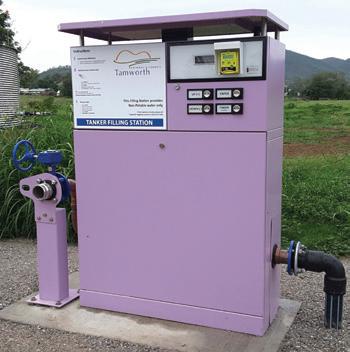
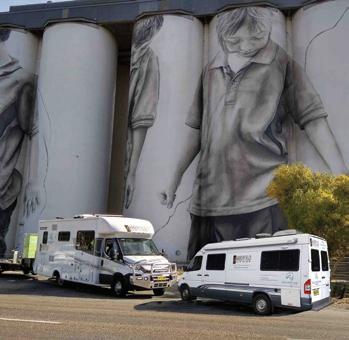
Abberfield’s place of business for decades past, finally owned by Abberfield Industries.
Designed & manufactured by Australians for Australian conditions.
n Highest quality for the lowest whole of life cost.
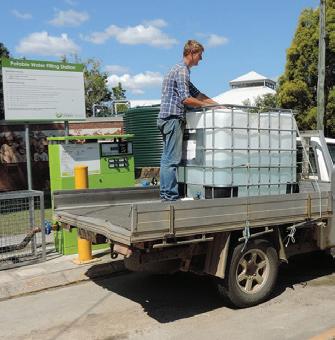
n Potable Water
n Recycled Water
n Bore Water
n Any Water
Designers & Manufacturers of specialist products since 1968.
The Colyer Family & the next generation
n Owner managed.
n Continuity & support assured.
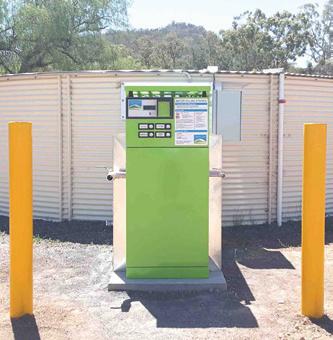
“You can buy petrol any where around Australia... but you can’t buy water!”... Yet. Abberfield’s mission is to change that statistic.
Whole of life support.
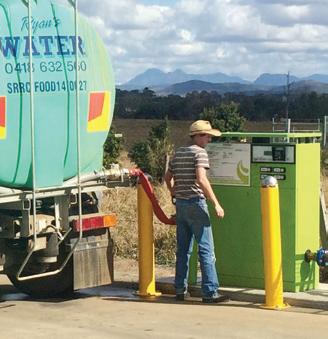

An unavoidable by-product of many industries, organic waste is challenging to remove and can have negative impacts on the environment if not disposed of correctly. Here we explore the innovative solutions that can transform this unwanted refuse into useful resources.
Removing organic waste is a difficulty many businesses face. It takes up precious space, smells bad, attracts pests, and is expensive to transport and manage. And, when it ends up in landfill, it rots without oxygen and releases methane: a powerful greenhouse gas that contributes to climate change.
However, Urban Utilities has been looking at organic waste not as a problem, but as an opportunity to improve the environment and businesses bottom line by creating valuable products like renewable energy, fertiliser, compost, and more.
For more than a decade, Urban Utilities has been utilising innovative technologies and methods to transform organic waste into useful resources.
Urban Utilities’ General Manager of Water Ventures, Matt Magee, said that Urban Utilities is currently co-digesting organic waste and wastewater sludge at its Luggage Point Resource Recovery Centre to produce biogas that is then fed into cogeneration units, which are essentially giant engines, to create renewable energy that powers operations and flows back into the grid.
“We can potentially also turn waste into biofertiliser, compost, biochar, and biochemicals, and we’re always looking for new ways to extract value, such as pyrolysis, hydrothermal liquefaction, and mycoremediation,” said Mr Magee.
Organic waste has a lot of potential to help both communities and the planet. However, to maximise its value, it’s important to work with a partner who can help you design, implement and run a successful waste valorisation program.
“We understand the power of partnerships and know that through genuine collaboration, we can achieve more than working alone,” said Mr Magee.
“We see a future where food and garden organics (FOGO) are processed at joint industrial waste precincts within three to five years, and we’re actively looking to expand our partner networks in this space.
“We have the infrastructure, licenses, and experience distributed across our service region to unlock tremendous opportunities for councils and other industrial partners, and we’re already seeing positive outcomes from our existing partnerships.”
In 2022, Urban Utilities signed a landmark partnership agreement with Cleanaway Australia, the largest waste management business in the country, to generate renewable energy from organic food waste.
The utility upgraded a liquid waste receival unit at its Luggage Point Resource Recovery Centre to allow its six large-scale digesters to directly accept and treat organic food waste as well as fat, oil and grease.
Urban Utilities now treats all the waste that these digesters collect from the region’s restaurants, as well as all the food the major supermarkets are unable to sell or donate, and uses it to generate clean energy.
“Food waste is an important challenge to address and, as our population grows, we want to avoid organics ending up in landfill wherever we can. We’re passionate about supporting a circular economy to promote a healthy, sustainable, and liveable future,” said Mr Magee.
Waste is only waste if it’s wasted, and with the right partner, it can be incredibly valuable to the environment and your bottom line.
Do you have an organic waste challenge? Urban Utilities is keen to hear from you. Scan to find out how the utility can help you maximise the value of your waste and meet your ESG (Environmental, Social and Governance) goals.
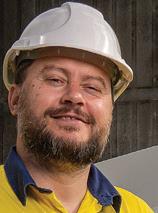


Scan to find out how we can help you turn your waste into wealth and meet your ESG goals. Scan here
urbanutilities.com.au

As Australia, and indeed the world, works towards sustainability goals, the necessity for innovation outside of the current industrial modes of use and dispose become more imperative. Utilities are on the frontlines of this change, working to develop ways of providing residents with essential services that are renewable, sustainable, and circular. Sydney Water has committed to working towards a circular economy with the development of the Upper South Creek Advanced Water Recycling Centre, located in the heart of the Western Parkland City. The new recycling centre presents a unique opportunity to activate a broader circular economy ecosystem for the management of water, energy and resources. Here, we look at why Sydney Water chose this type of facility, what benefits it will bring and what can be learned to help future circular economies thrive.
The term ‘circular economy’ is gaining traction globally in business, waste policy and management practices, particularly within the water industry. The Ellen Macarthur Foundation, a UK-based non-profit organisation that creates evidence-based research on the benefits of circular economies, defines a circular economy as: “Looking beyond the current take-make-dispose extractive industrial model, aiming to redefine growth, focusing on positive society-wide benefits. It entails gradually decoupling economic activity from the consumption of finite resources, and designing waste out of the system. Underpinned by a transition to renewable energy sources, the circular model builds economic, natural, and social capital. It is based on three principles: design out waste and pollution; keep products and materials in use; and regenerate natural systems.”
Sydney Water recognised that a circular economy is key to achieving its goal of net zero environmental impact. The largest utility in Australia, Sydney Water provides water and wastewater services to Sydney, the Blue Mountains and the Illawarra region. As detailed in Unlocking the circular economy in the Western Parkland City, Sydney Water Managing Director, Roch Cheroux, said, “We want to understand the circular economy ambitions of our stakeholders, and how we might work together to create a better life with world-class water services. We will realise this (net zero impact) by delivering better outcomes through integrated water solutions that will restore and regenerate natural systems, keep resources in use at their highest value, and economically design out waste and pollution.”
Sydney Water identified the site of the Western Parkland City (WPC) for its new Advanced Water Recycling Centre (AWRC). The WPC covers eight local government areas including the Blue Mountains, Camden, Campbelltown, Fairfield, Hawkesbury, Liverpool, Penrith and Wollondilly. The WPC is a major contributor to the national economy – its industries and city centres generate more than $56 billion per year Gross Regional Product.
The WPC presents 100,000ha of opportunity, surrounded by 700,000ha of rural and natural areas. The Western Sydney International (Nancy-Bird Walton) Airport will also be at the centre of the WPC, due to begin operations in 2026. The combination of industry and natural resources in the WPC presented a great opportunity for Sydney Water, with Mr Cheroux noting that the location provided “the rare chance to design a city that is not only comfortable and prosperous but is also sustainable.”
To initiate a conversation about how to activate the local circular economy, Sydney Water teamed up with NSW Circular to host a Discovery Workshop for more than 60 partners and stakeholders. This was followed by a Leaders’ Roundtable designed to test and hone the strategic opportunities identified in the workshop.
Out of the consultations, the Upper South Creek AWRC was born. Located between Kemps and South Creek in the WPC, the AWRC facility will service up to 400,000 dwellings in the Western Sydney Aerotropolis Growth area and, once constructed, will be one of the most advanced wastewater recycling facilities in the southern hemisphere.
The AWRC is designed to cater to the primary need of wastewater treatment – but that’s far from the only service performed by the facility. The recycled water, energy generation and waste reuse are set to provide big impacts for the entire community. The AWRC is designed to collect wastewater from the Western Sydney Aerotropolis Growth areas and treat it to the highest quality of water possible, called advanced quality water. The technology used is called reverse osmosis, the technology used in desalination plants, where wastewater from homes and businesses is treated to produce recycled water for a range of residential, agricultural and industrial uses. The plant will also be used to process other organic waste – such as food, fats, oils and greases –to create useful biogases and biosolids, making it one of the greenest infrastructure investments in New South Wales.
More than 80 per cent of Australia’s food waste is currently disposed of in landfill, where it decomposes to form methane, a potent greenhouse gas. Sydney Water's modelling found that the AWRC could divert up to 30,000 tonnes of organic waste from landfill per year by 2030,
Biosolids contain important nutrients that benefit the agricultural sector including nitrogen, phosphorous and potassium, as well as other valuable trace elements, such as copper and zinc. Sydney Water pioneered the land application of biosolids in the mid-1990s and 100 per cent of its biosolids have been used for almost 20 years. Biogas can be used to generate renewable electricity, as a fuel for vehicles or as a replacement for natural gas.
Upper South Creek has the potential to produce biosolids an annual value of up to $2.8 million. In addition, fats, oils and greases can increase biogas production by up to 80 per cent when co-digested with wastewater.
Sydney Water Major Projects Director, Stephanie Clarke says the utility is aiming to use the AWRC to generate highquality water to help protect waterway health in the West, in particular, South Creek and the Nepean River. In addition to producing high-quality water, Sydney Water is planning to offset potable use to avoid relying on precious drinking water supplies, such as Warragamba Dam.
“We expect to get interest from developers, industry, park and green space managers and businesses, including Sydney Airport, in the high-quality recycled water produced by the AWRC.
“We’re also working on how to make best use of the other renewable resources that are produced by the AWRC.such as renewable energy from biogas and biosolids that than be used as fertilisers in agriculture,” said Ms Clarke.
“One hundred per cent of the biosolids produced by the AWRC will be used in New South Wales as fertiliser. Biogas generation will happen via process we call co-digestion, which create gas or energy from wastewater. There is also the potential to expand this to generate even more energy from food waste.
“From a big picture perspective, we’re simply aiming to apply circular economy principles to produce the best quality and highest use renewable products from the wastewater treated by the AWRC.”
When operating at maximum capacity, the facility will treat around 70 megalitres of wastewater each day, producing high-quality treated water, renewable energy and biosolids for a wide range of sustainable reuse purposes.
What also sets the AWRC apart from traditional wastewater treatment facilities is its groundbreaking use of reverse osmosis to treat the wastewater. While this method of treatment is used extensively overseas, it is very new in Australia.
“We believe this is the first treatment facility in the Southern Hemisphere that treats 100 per cent of its wastewater to an ‘advanced’ quality, via reverse osmosis as an integral part of the wastewater treatment to protect our waterways. In traditional treatment facilities, wastewater is treated to a secondary or a tertiary class before release into waterways, and contained greater levels of nutrients such as nitrogen and phosphorus.
“There are plants in the Northern Hemisphere - in the United States and Singapore for example - that treat wastewater to the same high-quality standard. However, unlike the AWRC, they also use it for drinking purposes,” Ms Clarke said.
The project is also set to provide more security for Sydney’s future water supply.
“One hundred per cent of the wastewater that comes into the AWRC from the catchment will go to producing highquality water.”
“In addition, we're planning on further reducing the demand on Warragamba Dam via releasing the high-quality water produced by the AWRC into the Nepean River via the project’s environmental flows pipeline. This means we reduce the amount of fresh drinkable water from Warragamba Dam that is flushed down the river to keep that waterway healthy. This is called replacement flow and it reduces the pressure on Sydney’s drinking water supply,” Ms Clarke said.
It’s no surprise that groundbreaking projects come with new challenges. Although the WPC location offers many positive aspects for the project, it presents some significant construction challenges, too.
“Western Sydney is a very busy place from a construction perspective. The AWRC construction site is right next to the M12 construction site and we’re both building at the same time we are, so it's pretty congested. We acknowledge this and we're talking to the local community every day about how we can minimise our construction impacts on them, which includes coordinating our activities with our projects in the area,” Ms Clarke said.
“This project is also trying to achieve the Infrastructure Sustainability Council’s new 2.1 sustainability rating. We're one of the first projects to attempt this, so that's another real challenge we’re facing. There's a lot of work involved, particularly in relation to stakeholder engagement, but it’s an important goal for us to build best practice in sustainability into this project’s delivery,” Ms Clarke said.
Another challenge yet to come for the project is creating an economy of reuse – not just for the water itself, but energy reuse. So as part of the project, Sydney Water will be offsetting half of the facility’s energy generation – but over time, it is planning to build up to offset 100 per cent energy generation used.
“We don't know that technologies will develop over time, so we are making sure we're creating space and have the ability to adopt new technology in the future so we're not just building something based on 2023 technology,” Ms Clarke said.
With the first sod turned, construction has officially begun on the state-of-the-art project. While not due for completion until 2026, the Upper South Creek Advanced Water Recycling plant will set a new standard for sustainability in the utility sector and pave the way for other utilities to start designing infrastructure to support circular economies.
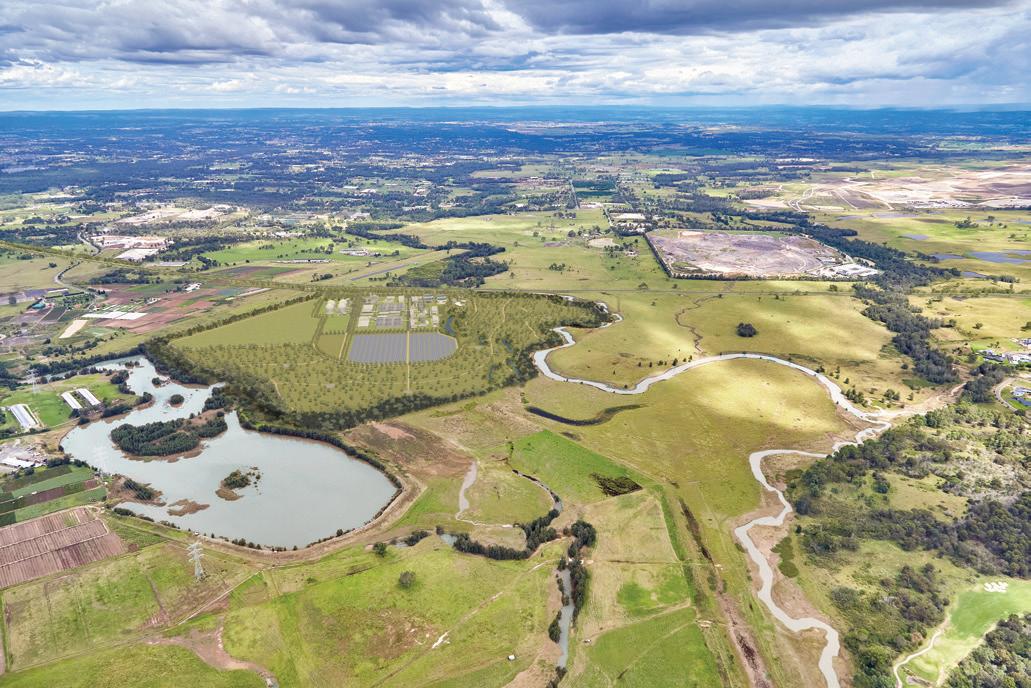
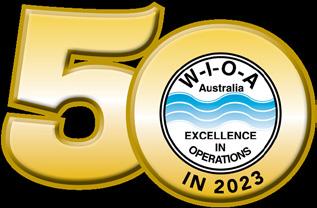
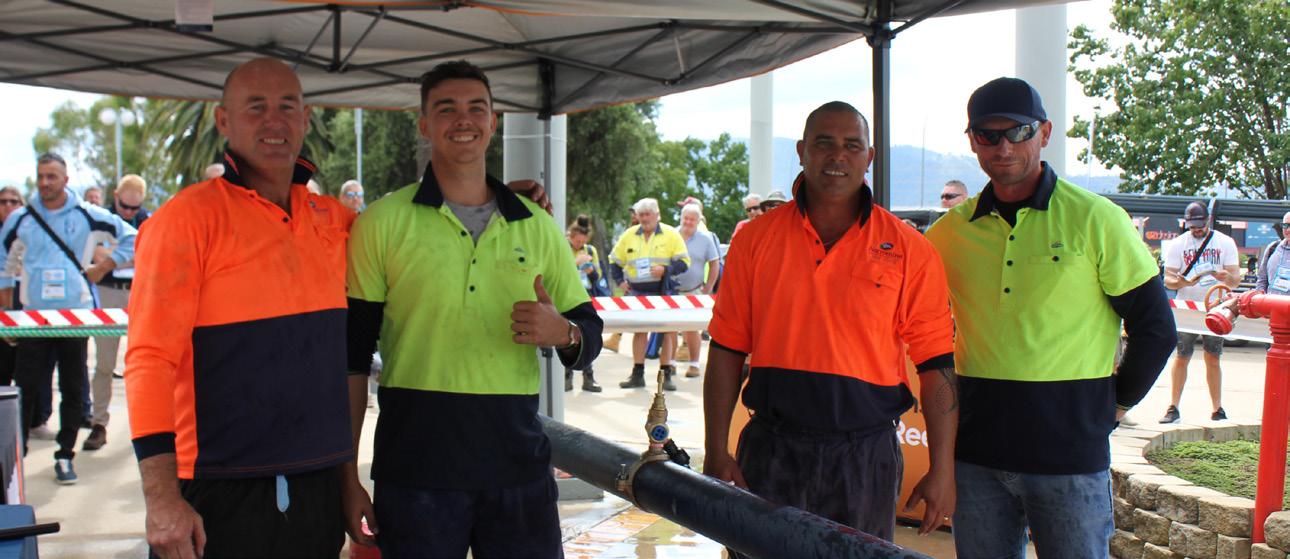
Promoting best practice in water management by building the knowledge, skills and networks of operators.
• Listen to the experience of others through the latest “operational” technical and research based information through platform and poster presentations.
• View and discuss the latest advances in technical equipment, products and services with suppliers and trade consultants.
• Update their knowledge and skills through interaction with fellow water industry employees.
All industry personnel involved in the operation and maintenance of water related infrastructure for the management, conveyance, treatment, discharge and reuse of water and trade wastes should attend this conference.
• 20+ speakers over 2 days
• 90 of the world’s leading water suppliers on display
Supported by Hosted by

Prime Sponsors
• Ixom 2023 Best Tasting Tap Water in NSW/ACT
• NSW Main Tapping Competition
Media Partners


Sandra Jefford and Wilco Droppert own and operate Wilandra Farms, an organic dairy farm in the Gippsland region of Victoria. However, despite the farm’s success, its irrigation and dairy operations were using about 500,000kWh of energy per year. Energy costs were high and irrigating the farm was a costly and time-consuming process. In 2019, the couple sought an energy audit to identify potential energy savings and streamline operations. The energy audit revealed not only huge cost savings for the farm, but also great potential for sustainable energy transitions.
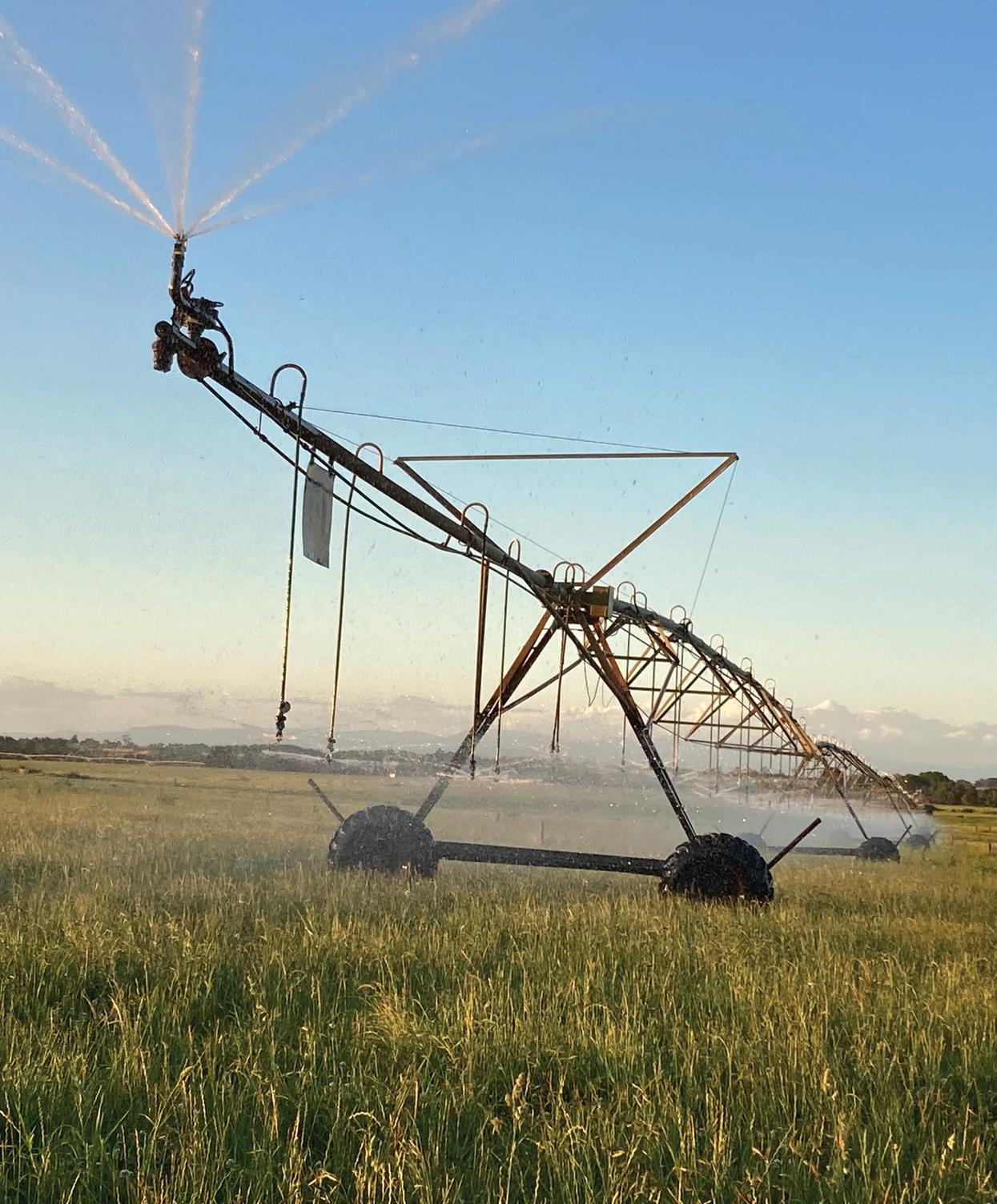
Sandra and Wilco moved to the Gippsland area in 2011 and began farming organically in 2016. Located at Clydebank, Wilandra Farms is a certified producer of milk, silage and hay, and the property houses 380 certified organic dairy milk cows year-round.
With the success of the farm have come bumps in the road. The couple realised that the farm’s energy costs were too high, particularly in relation to irrigation – which was accounting for 70 per cent of the power used on the farm. They had been using a diesel pump to pump water from the dam to pivots, which was not only expensive, but bad for emissions and a huge drain on manual labour.
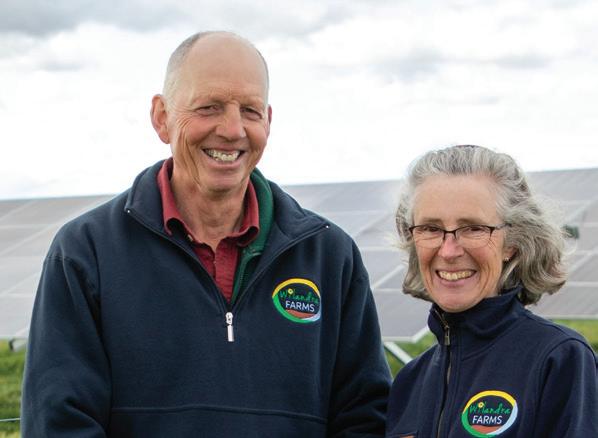
The farm’s soaring energy bills led the couple to pursue an energy audit. While the purpose of the audit was initially to lower costs, Sandra and Wilco realised that there were other benefits to upgrading and updating their irrigation equipment. The energy audit opened their eyes to the potential benefits of renewable energy – which could also save the couple hours of work every day.
“Our energy project started because of the big energy bills, particularly for irrigation. And it was after we'd had the energy audit done, we then started to look at emissions related to energy, and then that set us on the track of looking at emissions further. It was really the energy bills that started the whole project,” Sandra said.
The energy audit revealed multiple deficiencies in the farm’s current equipment and areas for potential improvement. Sandra and Wilco pumped all their irrigation water from bores and the Avon River, traveling through lengthy pipelines. The audit uncovered two key pieces of equipment that would have far greater capacity if replaced – the existing bore pump’s motor was too big, and a 500m pipeline was the wrong diameter. These two improvements alone are estimated to have reduced power use by about 37 per cent at the pumping site.
The couple were also using a diesel-powered pump to pump water from the dam to pivots. Because the pumps and pivots were not automated, the couple were frequently having to drive between them – costing them valuable hours
every week. The manual diesel pump was constantly working, not able to adapt to changing conditions, which meant that emissions were also much greater than necessary.
Sandra and Wilco opted to install two 37kW Caprari electric pumps to replace the diesel pump that was used to pump water from the dam to the pivots. This had many benefits for the farm – the pumps can be operated remotely via phone or computer, saving the pair many hours each week of having to drive between pumps and pivots.
The variable speed pumps also improve energy efficiency by ensuring that the irrigation system does not run when it doesn’t need to. For example, in 2022–23, the area was very dry from mid-December to late March – so the irrigation system needed a lot of grid power. The system was able to adapt easily to the change in conditions, resulting in very little peak price power.
“There's lots of benefits. We are saving at least 15 hours a week, maybe 20 hours a week in busy irrigation times because of the automation, because we don't have to drive to the pumps and the pivots anymore. We can stop and start things from a laptop,” Sandra said.
“And we’re seeing big energy savings. January and February were extremely dry, so we pumped a lot of water. Even so, our cost of energy for irrigation was only six cents per kilowatt hour. And so another advantage is with all the talk of the price of electricity increasing, we're quite nicely protected against that now because we don't need that much grid power,” Sandra said.
The couple also replaced two old, oil ring vacuum pumps with a lobe vacuum pump, resulting in less power demand and a far cleaner vacuum pump with no need for oil changes.
To lower energy costs whilst also investing in more sustainable solutions, the couple worked with Alternate Energy Innovations (AEI) in Morwell to develop a Renewable Energy Action Plan.
They received funding through the Victorian Government’s Agriculture Energy Investment Plan to help with costs. So far, renewable infrastructure updates include the installation of 200kW of solar energy and 56kWH of batteries, with four 5kW wind turbines also in transit to the farm for installation –which has meant huge savings on the cost of electricity.
“We have dropped the price of power that we're using for irrigation down from 27 cents per kilowatt hour down to six cents per kilowatt hour this year. We've still got our equipment finance loan to pay off, but we've already been paying that off now for about two years, so we've only got five years. Then it's paid off, and we've got free energy generation. In terms of the total energy costs for irrigation, depending on the year and how much water we're pumping, we were spending between $80,000 and $100,000 on energy costs for irrigation,” Sandra said.
The investment in renewable energy enabled another big change – connecting the bore pump to solar energy. The farm houses solar panels facing north, east and west to maximise the amount of energy they can produce. Solar powers the pumps, and with the installation of variable speed pumps, energy efficiency has further improved by ensuring that the irrigation system doesn’t run when it doesn’t need to.
“With the bore, it's connected to solar power. Once we've got a low level of solar power early in the morning, that bore starts slowly dumping water in the dam. We are able to use a low level of farm generated power. The solar power is so successful, in future we will look at putting in more solar power because with it being so dry this past summer, we were using a lot of off-peak grid power, and in the future we'll try and replace a lot of that with farm generated power,” Sandra said.
With many positive changes implemented, Sandra and Wilco are keen to continue with their renewable upgrades. One challenge the couple faced was with the installation of additional wind turbines. The couple expect to add two 15kW turbines to their existing stock of four – but due to a technical problem with the manufacturer in the UK, they are still waiting.
“We've got four five kilowatt turbines here as a temporary measure, and eventually we expect we'll have two 15kW turbines, because there was a technical problem with the manufacturer in the UK. And then there's been a problem getting inverters to be compatible with the turbines. And I think this is just because turbines at this sort of scale are still very unusual and the inverter manufacturers are not putting the effort into making the inverters to match the wind turbines,” Sandra said.
The electricity grid posed another challenge for Wilandra. There is no smart grid at the farm, so electricity generated at the farm goes into the grid, which they sell to for six cents, but they then have to buy it back from the grid for 36 cents. The
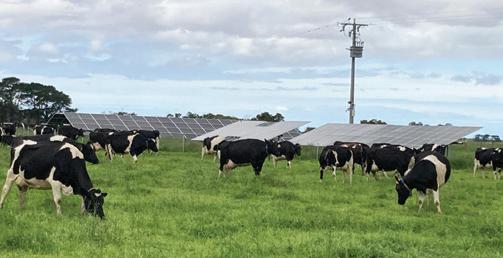
couple said the grid needs a system that allows them to allocate the excess power elsewhere, rather than across a range of separate meters.
The couple also had the intention of installing a microgrid. Microgrids provide energy generation and storage at a local level, which would have enabled the couple to generate, store and sell even more renewable energy. However, strict regulations around microgrid installation meant that the couple had to alter their generation and storage plans.
“We had hoped to run a controlled microgrid on the farm, but the regulations are such that that's just not possible at the moment. But if farms were able to use controlled microgrids, they could make much better use of the renewable energy that they're generating. It becomes more cost effective. And we could hopefully see more farmers installing renewable energy on their farms, but we need a change in regulation,” Sandra said.
Despite these challenges, Sandra and Wilco are optimistic about further renewable upgrades to the farm – particularly the installation of more solar panels.
“Like a lot of other farmers, we've got land that isn't the right sort of size and shape to put a pivot on. We've got a project just getting started to put in fixed sprinkler irrigation using surplus solar power at a particular bore site where we've got 50kW of power. That's underway, and in future we'll have another look at how much solar power we need, and we'll probably look at putting another pump at the dam, so that each center pivot has its own pump that's pumping out of the dam to a pivot, because that'll make the automation easier. At the moment, we've got three pivots and they share two pumps.
“So there’s plenty to do – we just need a good strong milk price to enable us to keep going with all these improvements,” Sandra said.
The couple recommend solar energy installation for all irrigators, saying that the cost savings, coupled with the huge environmental impacts, are hard to ignore.
“I think particularly for any irrigators, if you are using grid power, it's really worth having a look at installing solar energy. Particularly if you've got a dam, if you've got the ability to pump into a dam and then pump out, you can get some massive benefits with solar power,” Sandra said.
To encourage other irrigators to move toward renewable solutions, the couple hosted a knowledge-sharing event in February 2023, titled “Smart Farm Power – Opportunities in an uncertain carbon future”. Participants attended presentations and then visited the farm to view the automated irrigation and renewable energy system, and other features of the Wilandra Farm’s regenerative farming system.
Sandra said she felt it was important for the dairy industry to unite on a progressive path.
“I think farms can play a huge role in reducing emissions, and a collaborative approach using microgrids could even reduce the need for transition lines – that’s our hope for the future and we’re excited to share the results of our project to inspire others,” Sandra said.
An increased demand for transparency and accountability in underground pipeline and conduit installations leaves organisations with a lot of boxes to tick. These days, it’s no longer enough for contractors to simply prioritise speed in their installation works; they also need to deploy sustainable methods.
When searching for sustainable construction methods, it’s hard to look past horizontal directional drilling (HDD) for pipeline and conduit installation across the utility sector.
So, what makes HDD a more sustainable choice? There are four clear factors:
1. Reduced footprint, leading to less damage to the surrounding environment
2. Reduced waste material sent to landfill
3. Reduced impact in heritage and sensitive habitat areas by installing under rather than through
4. Reduced overall power consumption
The reality is, installing a pipeline either via trenching or microtunnelling is a project with a large physical footprint. Whether displacing large amounts of dirt for a trench, or digging a substantial pit for a microtunnelling machine to launch from, there is significant disruption to the surrounding environment.
HDD on the other hand offers contractors the ability to ‘go under’, offering a small, controlled construction zone with a relatively easy to manage footprint. Installing pipelines via HDD allows organisations to be leaders in sustainable construction through mitigating the unnecessary waste and environmental disruption that comes with traditional open trench installation. It also reduces the community impacts that critical infrastructure works often create.
Open trench installations require the excavation of large amounts of earth and dirt, usually across large areas. These trenches then need to be lined with imported mined bedding material which leaves a large waste stockpile to dispose of.
With HDD, drilling commences above ground, and directly into the pipe or conduit route via a small entry hole and exits at a smaller exit pit. HDD displaces less waste than other methods of pipeline installation, which require digging large trenches to lay pipelines or pits to house tunnelling machinery.
The drilling fluids used in modern HDD are environmentally friendly and biodegradable. The waste material is entirely recyclable and is regarded as an excellent additive in reuse applications such as turf production and soil enrichment due to its hygroscopic properties.
In addition, at AHD we are importing a new state of the art waste separation system that will set new benchmarks for compact and efficient dewatering and recycling of drilling fluids. Overall, these types of innovations will reduce water use along with the volume of waste material sent to landfill.
There are a great number of rules and regulations pertaining to heritage-listed sites around Australia, especially when it comes to making changes or carrying out construction.
At AHD, our motto is "Why not go under?" Going over causes more impact to vegetation and disruption to local animal habitats. Going under avoids all this by providing a small, controlled construction zone with a relatively easy to manage environment and vastly reduced impact to heritage zones.
We now possess the technology to drill in continuous lengths for over a kilometre at diameters up to 1.5m. AHD can drill the tight grades required for gravity sewer installations to untold depths without the need for costly shoring. HDD technology allows us to curve the drill path to avoid obstacles or to join non-aligned points in space. We regularly design drill shots to go around heritage assets and exit in small windows outside sensitive areas.
HDD offers an unparalleled lack of disruption to the prevailing ground conditions which, in turn, results in a vastly reduced impact to heritage zones. This can also speed up projects as it mitigates the need for lengthy permit and approvals processes.
In the race to decarbonise and meet net zero emissions goals, every little bit counts. Ambitious net zero targets call for emissions reduction processes across all fronts, including pipeline installations in the water, energy and telecommunications industries.
This is underscored by the fact that utilities are major consumers of energy. Reducing the energy intensity of any and all parts of their operations will be of critical importance in the years ahead.
When employing HDD installation methods, organisations can construct assets that are delivered on time and within budget while using less pumping power or energy over their lifespan. It can connect the closest points which couldn’t be considered using traditional methods. HDD truly can bring asset owners a step closer to meeting their emissions reduction targets.
Widely regarded as an industry expert, Anthony began drilling in 1994, and has overseen HDD installations since the technology first arrived in Australia. Of particular note, Anthony was the first person to undertake the HDD installation of polyethylene pipeline for the Australian water industry in 1995. With his extensive history and experience in the Australian HDD industry, Anthony has used his knowledge to develop several innovative patents for equipment that are still in use today. Anthony founded AHD Trenchless in 2009, and since that time he has built the company into an undisputed leader of HDD technology in Australia.

While traditional trade publications have quality audiences and high levels of trust, they can lack the full range of services to guarantee a return on your investment. And while traditional marketing agencies offer the latest marketing techniques, they don’t have the audience or the industry understanding the B2B sector needs.
Monkey Media is the missing link that brings together a trusted brand and powerful audience, with a complete agency offering.


For accurate, sustainable and efficient pipe and well installation
Horizontal directional drilling (HDD) is the least disruptive method of pipeline installation for the utility sector.
It’s a better whole-of-life cost installation method with a minimal footprint to protect the surrounding environment.
When your Asset needs to go under a river, highway or rail-line, AHD have got you covered.
AHD Trenchless is Australia’s most experienced HDD contractor –visit www.ahdtrenchless.com.au to learn how we can help you, or call 0418 399 062.
Polymaster’s unique Enclosed IBC Bund solves many of the problems associated with IBC storage and chemical/fluid decanting in a weather resistant, purpose-built enclosure.
Æ Full weather protection – stops rain entering the enclosure
Æ Easy forklift loading with wide forklift access from both side and back
Æ 250ltr day tank
Æ Lockable cabinet to keep system secure
Æ Venting by two sides
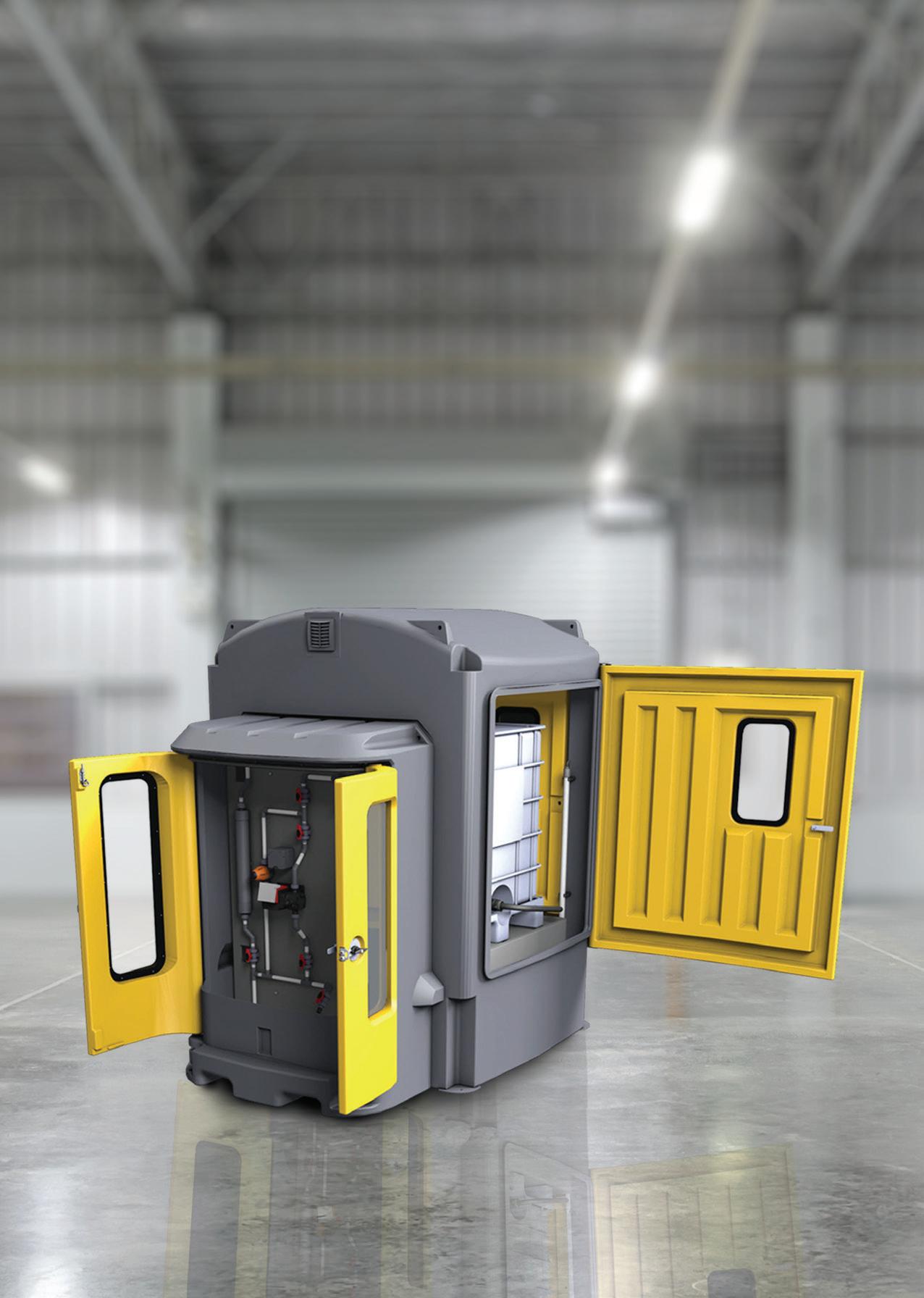
Æ Viewing windows incorporated into the doors
Æ 110% bund capacity complies with AS3780
Æ Sight tube and low-level alarm available
Æ Chemical resistant – high grade polyethylene construction